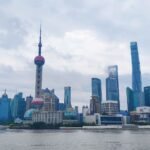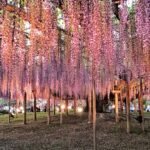DAY1
You cannot use a T-Money card to purchase tickets for the direct express train from Incheon Airport to Seoul Station on the Airport Railroad Express (AREX). Tickets can be bought on-site or through online platforms, with the fare being twice as much as the regular train. The advantages of the express train include reserved seating, fewer passengers, shorter travel time, and in-train T-Money card purchasing services. However, there are fewer train departures. The regular train offers more frequent departures but with the trade-offs of more passengers and longer travel times. Both trains have different entrances but offer metro transfer discounts.
For convenience, we chose the express train. Hanatour requires tickets to be purchased a day in advance, while Klook allows you to purchase tickets online on the spot and then redeem them for the next available train at the self-service ticket machine by entering your booking number.
Both the seatbacks and the train tickets provide guidance on how to transfer to the subway, but they do not mention a peculiar transfer detail: when holding an AREX express train ticket, you must exit the station on B3 and immediately re-enter to receive the subway transfer discount. This extra step is necessary to apply the discount, though it is not explicitly stated in the instructions.
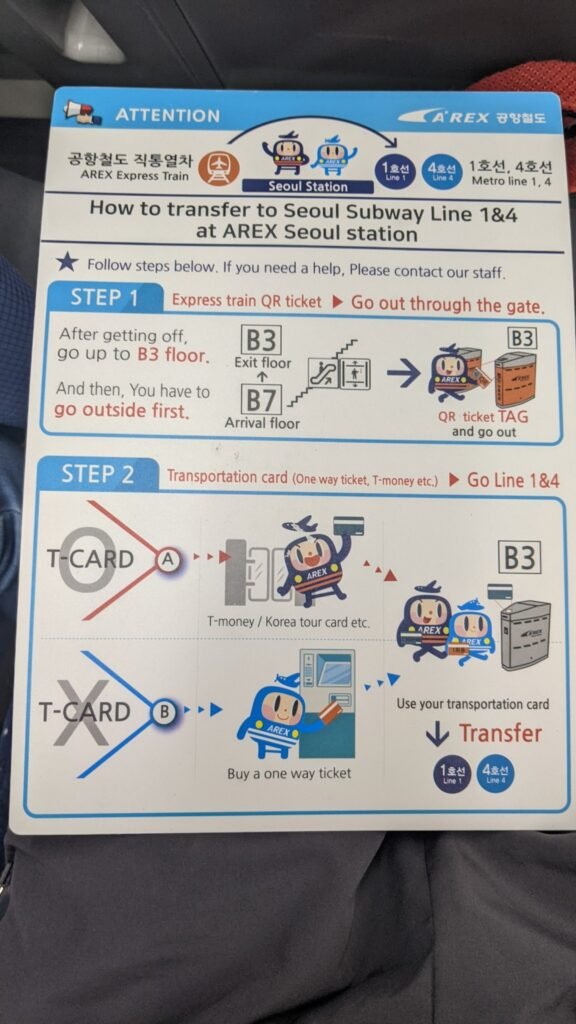
So, after arriving at Seoul Station from B7 to B3, following the signs for Line 4 and skipping the yellow “exit” markers, I was confused when my T-Money card showed an error at the subway entrance. In my confusion, I didn’t realize that I needed to exit with the express train ticket and then re-enter using the T-Money card to successfully transfer. Fortunately, a kind subway staff member was there. I first asked if I needed to go back and exit, but she reassured me that it wasn’t necessary. I then explained my issue with the T-Money card not working, and she smiled understandingly and let me pass through via the side gate.
Only now do I understand the odd logic behind this exit-and-re-enter process. I am very grateful to the staff for helping me, especially since I was struggling with my large bags. However, the need for this strange back-and-forth at the station still doesn’t make much sense to me.

After experiencing this strange transfer process, we followed Google Maps—which, unfortunately, lacked walking directions—through a metro exit without escalators, navigating our way around until we finally found our hotel. The room layout was nice, and the view of the seaside at night from the window was a lovely bonus.

From Google Maps, we noticed that many nearby restaurants were starting to close, even though it was only around 9 PM. We quickly headed downstairs and found a small eatery that was still open. The kind owner fired up the stove and prepared us bowls of noodle soup and kimchi stew.
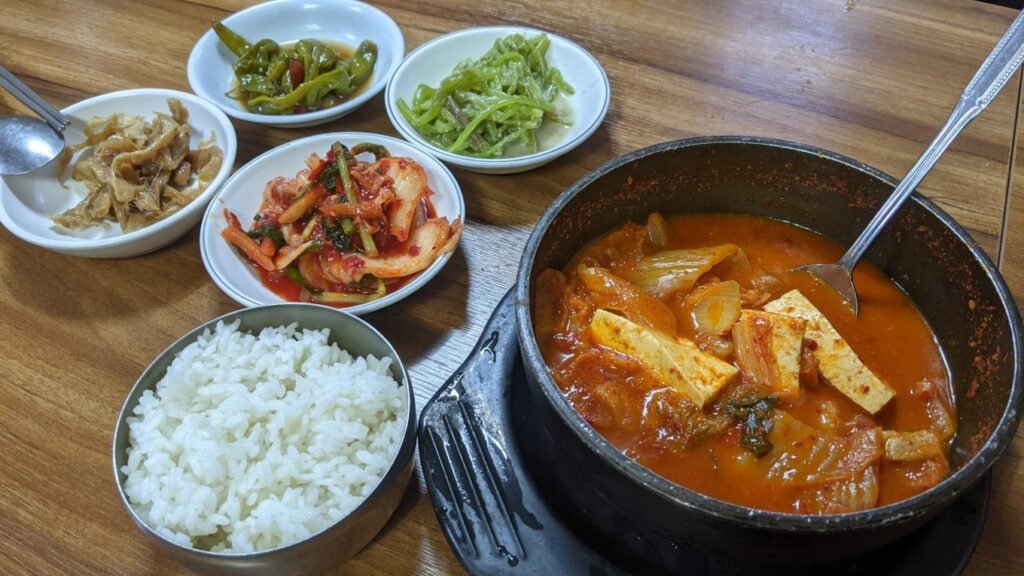
The contrast between the lively night market lights and the quiet, sparse streets created an interesting atmosphere—a mix of warmth and solitude.

DAY 2
Perhaps due to the jet lag, despite a restful night, I woke up before 5 AM. Although the sky was overcast, the forecasted light rain hadn’t appeared. Since today’s planned visits to Changdeokgung Palace, Bukchon Hanok Village, and the National Palace Museum wouldn’t start until after 9 AM, I decided to head to the Han River in Seongnam first to enjoy the misty riverside view, followed by a visit to the Olympic Park in the east, to explore the legacy of the 1988 Olympics.
I had hoped to find breakfast along the way, but to my surprise, none of the nearby restaurants were open yet—not even KFC or Burger King, which wouldn’t start serving until after 9 AM. I ended up grabbing breakfast from a food stall near the subway entrance, simply ordering what the customer ahead of me had—egg bread and gimbap.

In the early morning, the subway station was relatively quiet, likely due to the early hour.
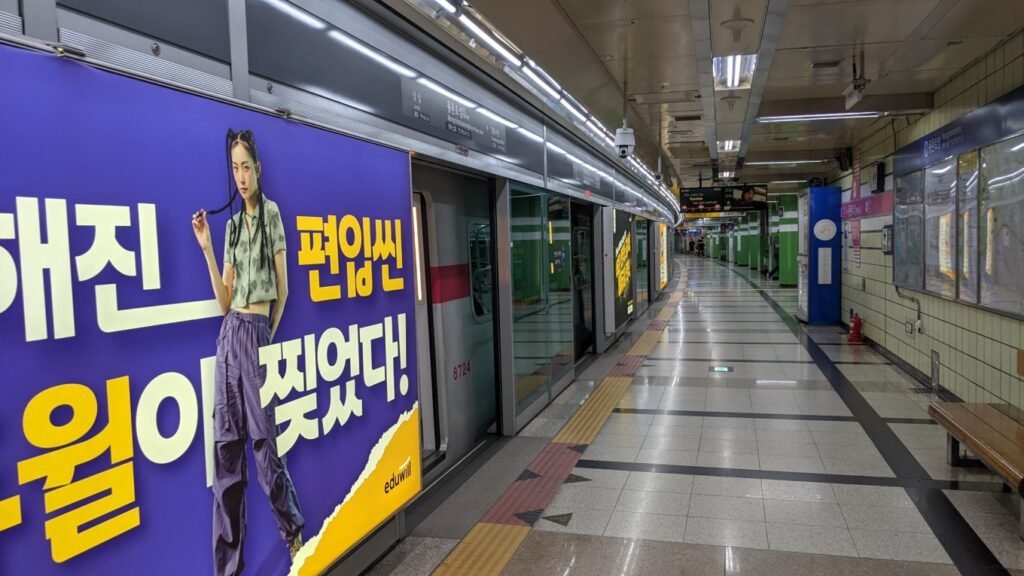
The Seoul subway map looks quite complex, but they’ve made it easier by numbering each station according to the subway line. This numbering system really helps passengers quickly identify the stations and navigate through the network.
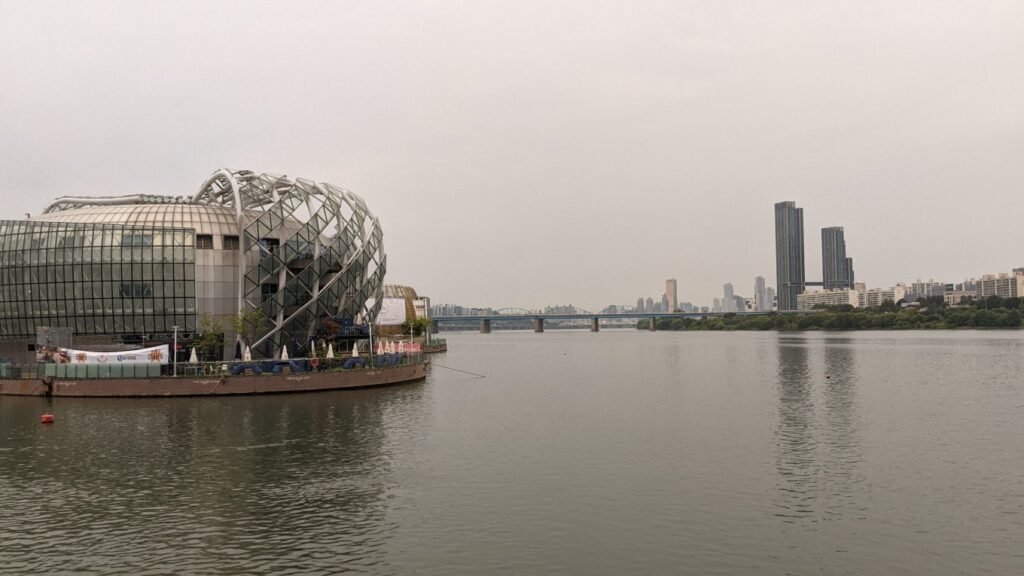
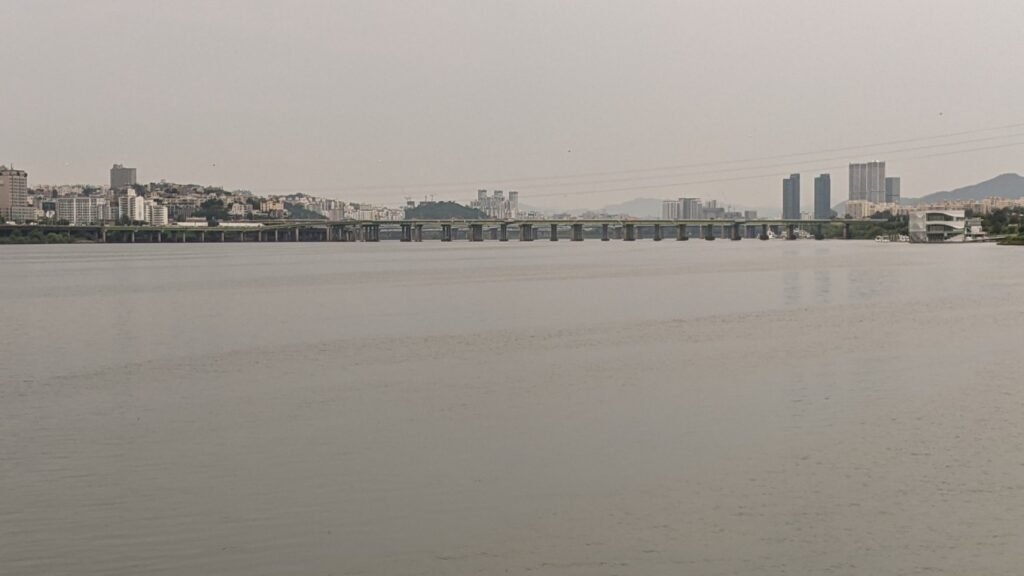
The banks of the Han River are shrouded in heavy clouds.


The double-decker bridge that spans the river has not only a roadway for cars on the lower level but also dedicated bike lanes and pedestrian paths.
The magnificent 1988 Olympic Village.
As soon as you step out of the subway station and onto the street, you’re greeted by the Peace Gate, which resembles a bird spreading its wings in flight. Beneath its wings are filled with elements of Korean culture, and in front stands the mascot of the 1988 Seoul Olympics. Under the gate is a semi-circular stone mound featuring an inscription by then-President Roh Tae-woo, who, as the chairman of the Olympic organizing committee, oversaw the construction of the Olympic Village and was elected President of South Korea shortly before the opening.



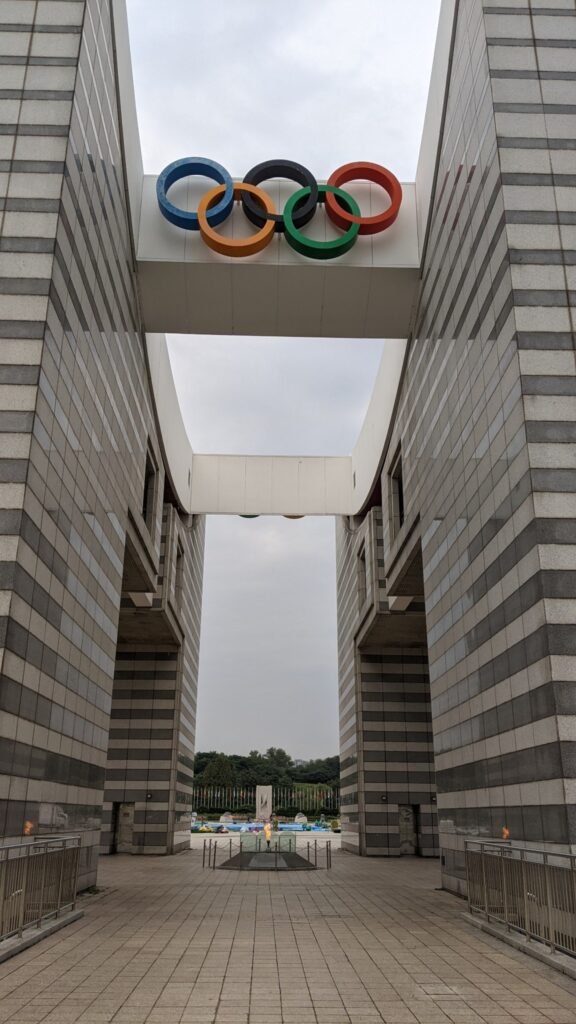
Inside the Olympic Village, there are also some facilities showcasing traditional Korean culture. One of these is a display of a water-powered rice mill — the flowing water turns the waterwheel, which drives the wooden pestle inside to pound the rice.
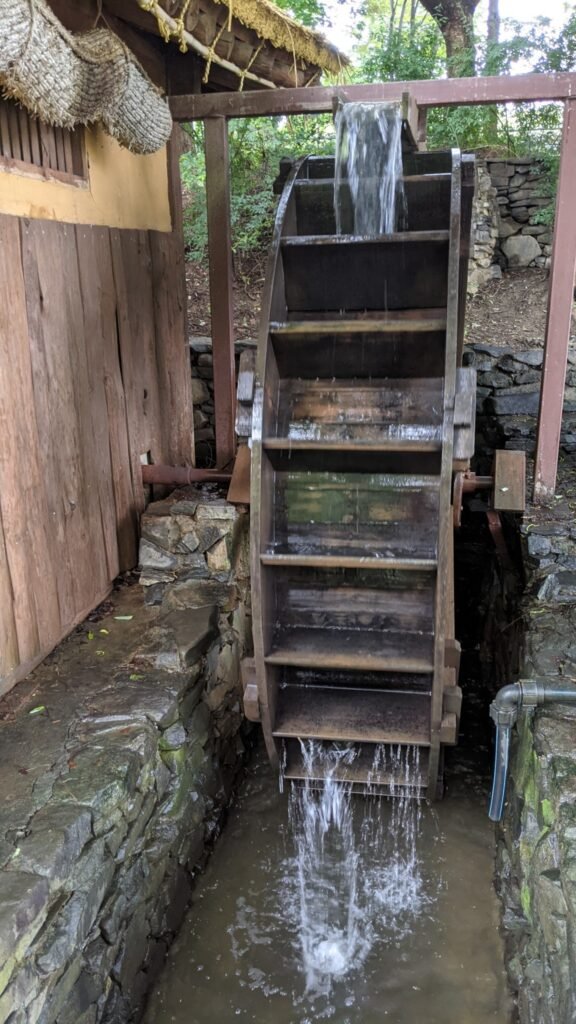
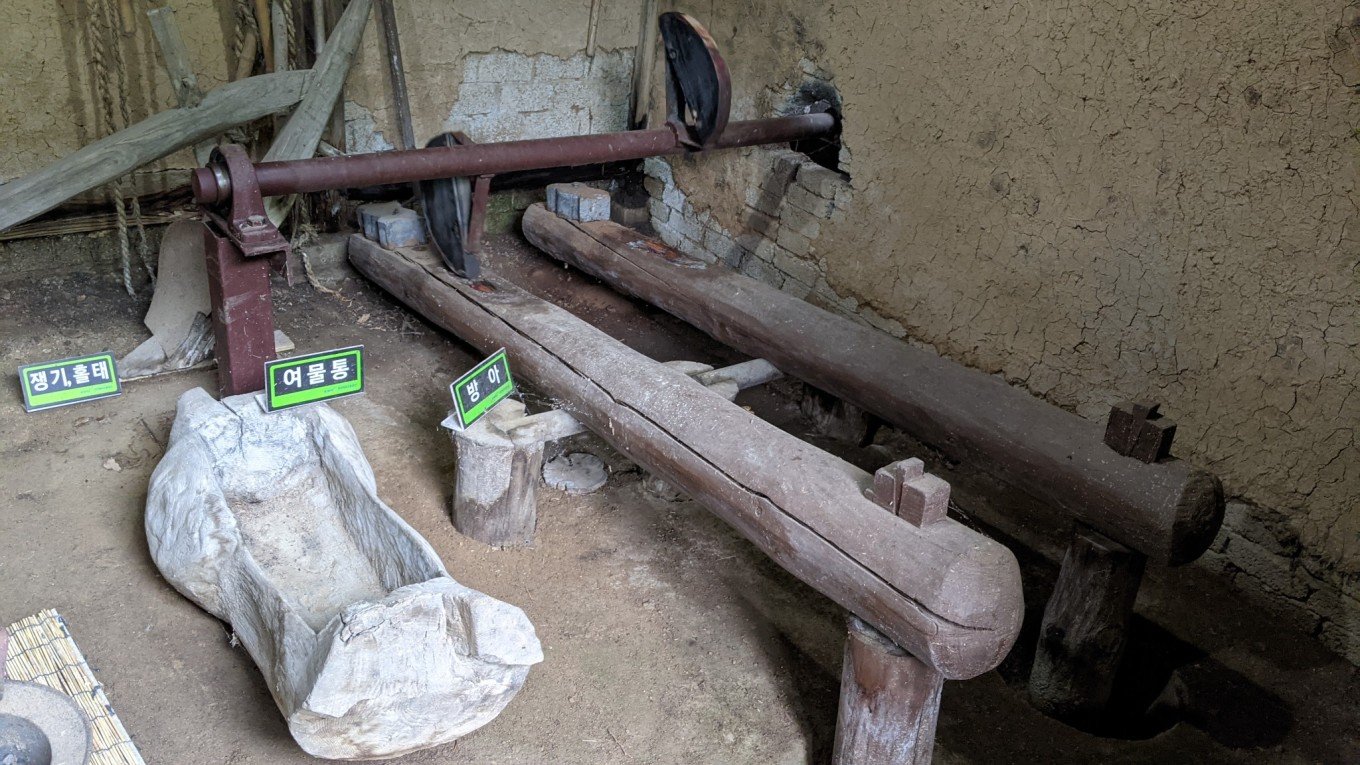
The Sculpture Garden inside the Olympic Village.
Dialogue can bridge the divides that arise from differences in region, language, culture, or politics. Near the ’88 lawn stands a collection of metal sculptures — they may seem similar at first glance, but each one has its own distinct features, celebrating individuality within a shared commonality.

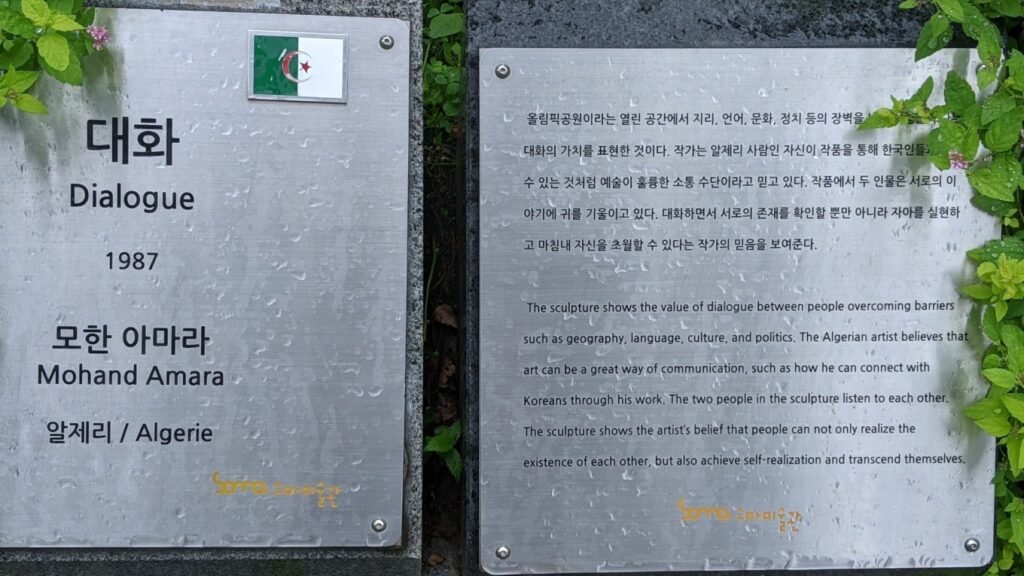
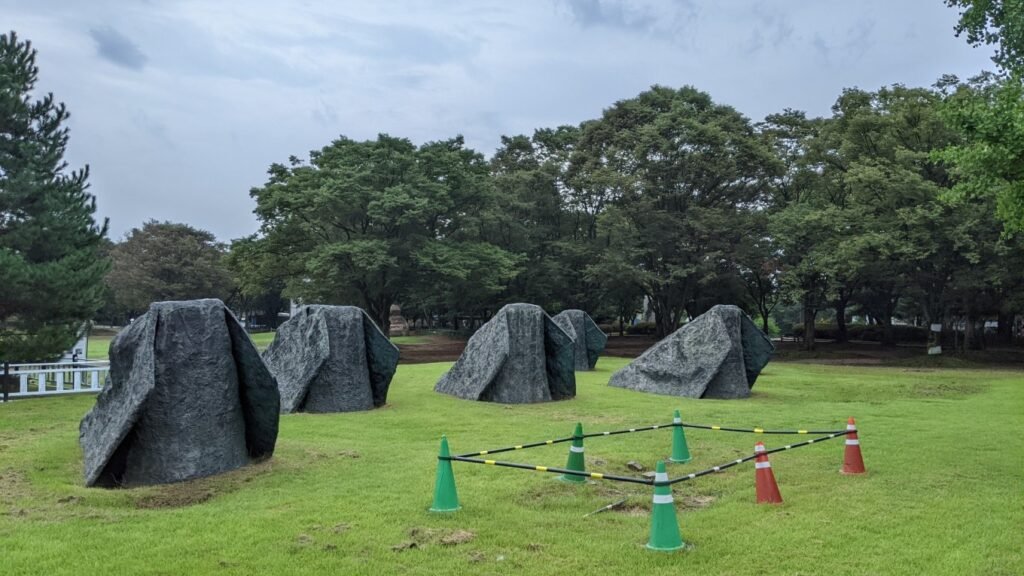
The 1988 Seoul Olympics marked the second time in modern Olympic history that the Games were held in Asia (the first being Tokyo, Japan, in 1964). It was a successful showcase of South Korea’s image to the world, laying the foundation for the country’s rapid economic growth in the decades that followed.
The Ruined Changdeokgung Palace
Gyeongbokgung Palace, Seoul’s largest royal palace, was closed today (Tuesday), so I headed instead to the secondary royal palace, Changdeokgung.
Changdeokgung was built in 1405, slightly later than Gyeongbokgung (1395). After Gyeongbokgung was burned down by Japanese invaders in 1592, Changdeokgung became the primary royal residence. Most of the current structures were rebuilt in the 1990s.
Like other royal palaces in Seoul, Changdeokgung offers free guided tours daily in Korean, Chinese, Japanese, and English at different times. Our tour guide was a middle-aged woman with a thick Korean accent, and there were only three visitors in our group. Just inside Donhwamun Gate, the meeting point for the tours is located next to the map on the left side.
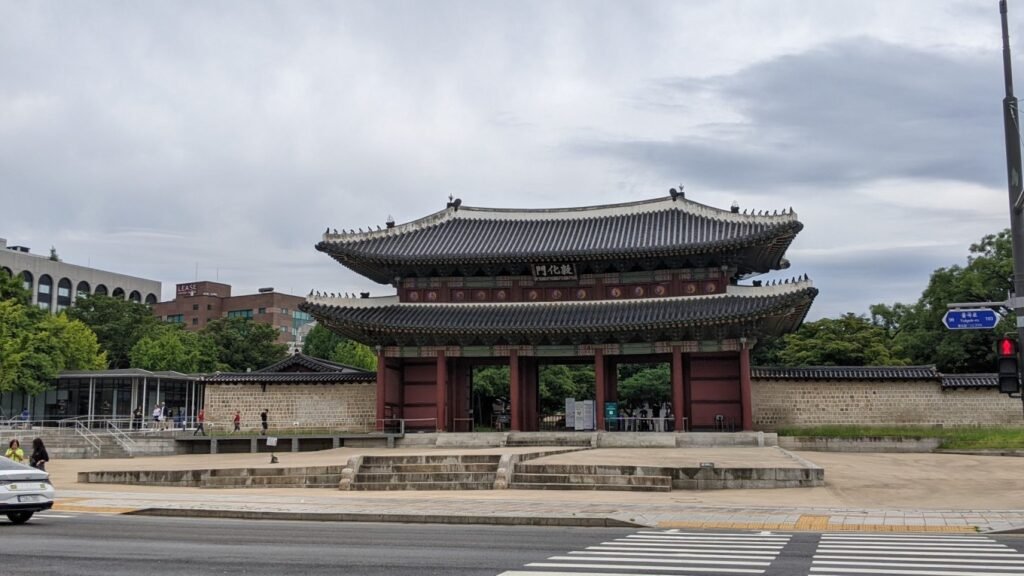

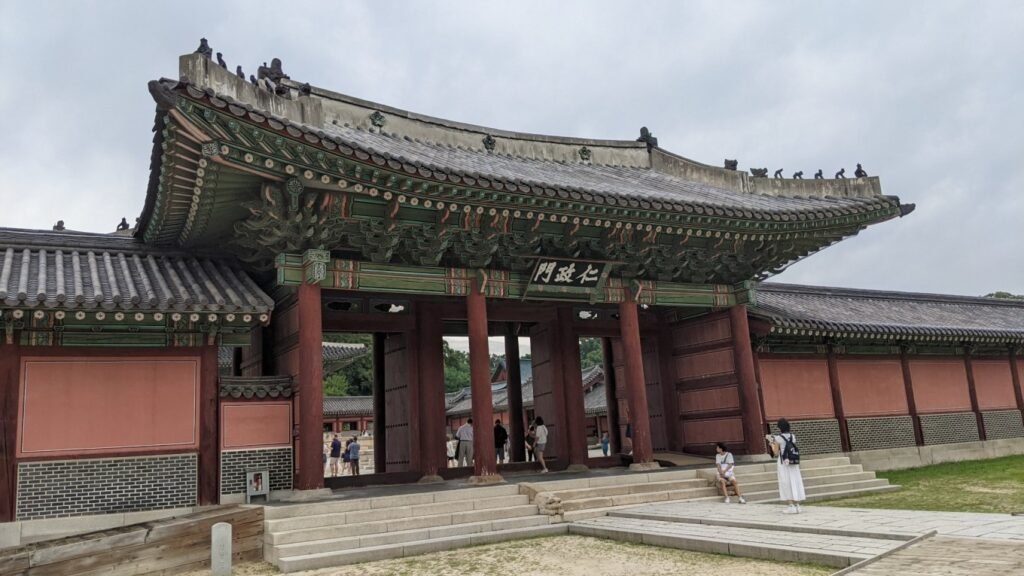



Inside Changdeokgung’s Injeong Gate are several pavilions and towers. According to the guide, a young king once lived in this courtyard, but after his death at the age of 23, it was left uninhabited. In 1962, Princess Deokhye, who had been held as a hostage in Japan, was brought back and placed here. She lived in this residence until her death in 1989. Since she was born of a concubine, she was referred to as “Ongju,” a title for daughters of lesser rank in the royal family.
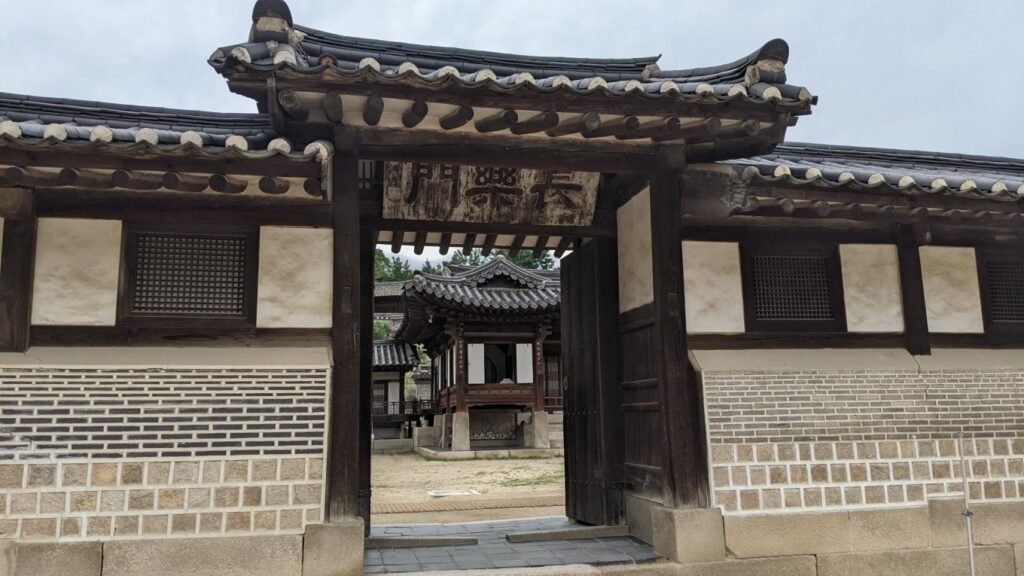
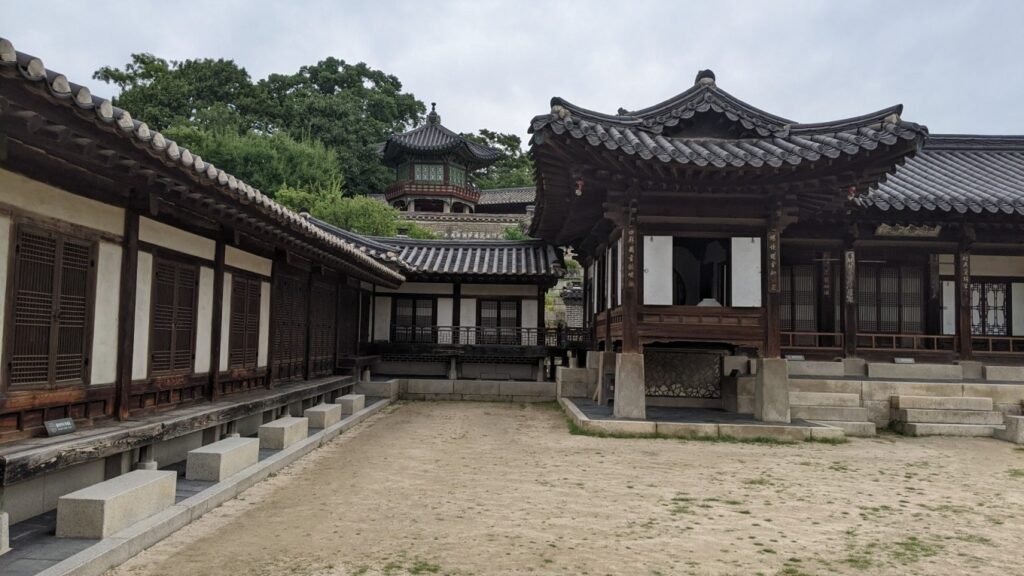
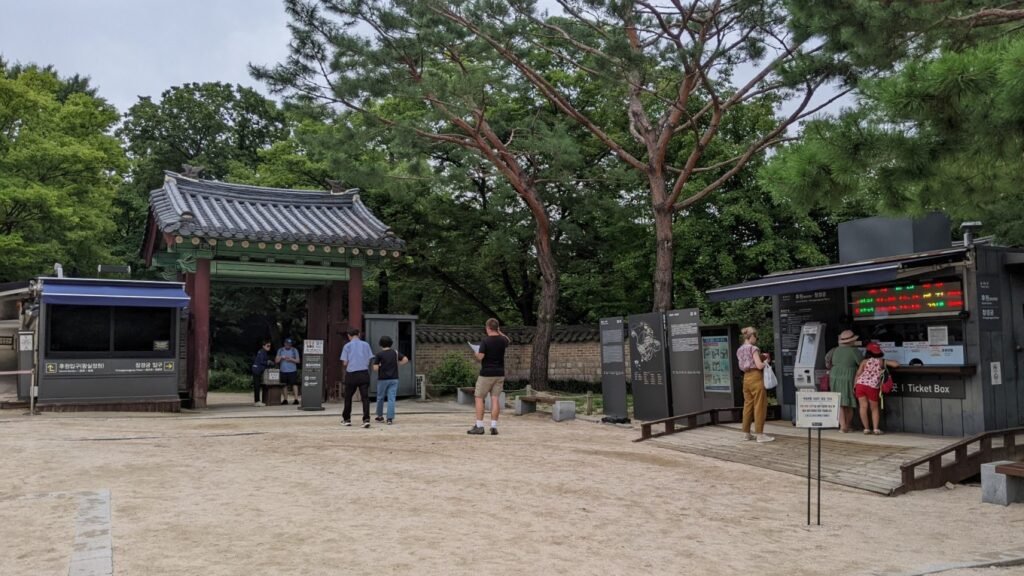

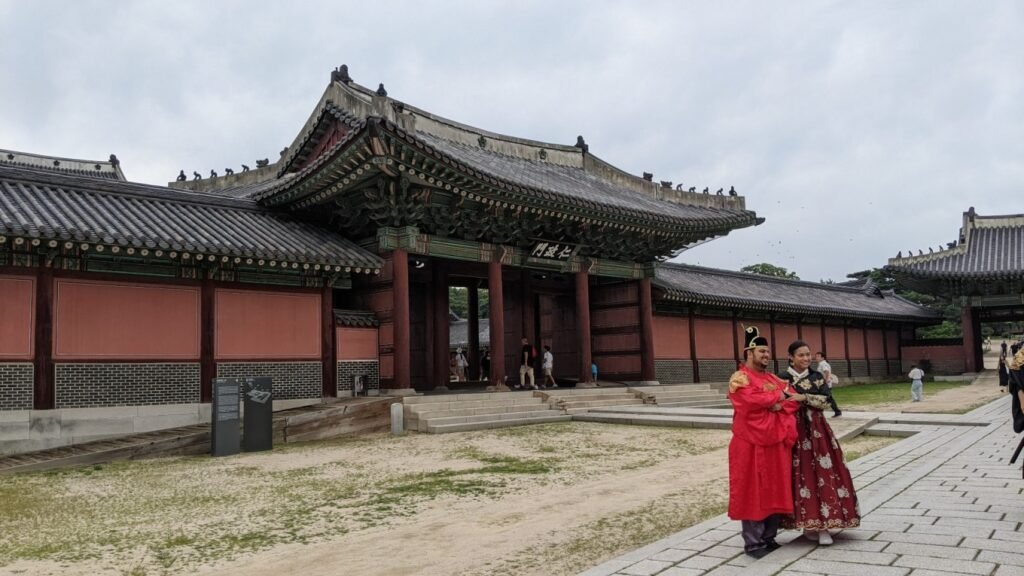
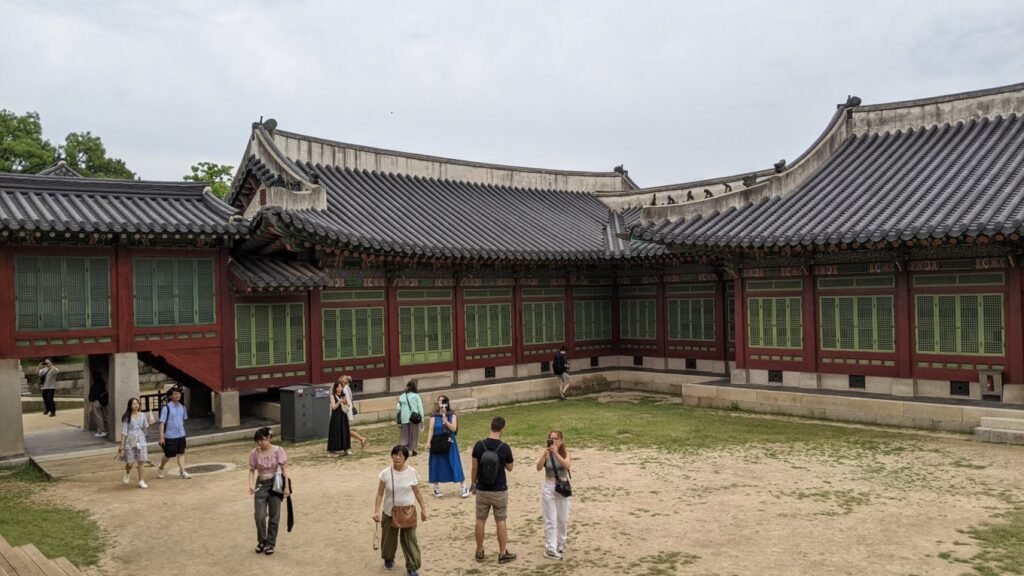
The Grand City Hall
I originally went to see the guard-changing ceremony at Deoksugung Palace, but I arrived too early, so I decided to take a stroll over to the nearby City Hall.
The low brick-and-stone building in front is the old City Hall, while the glass-walled structure behind it is the new City Hall. The two are connected by an under-construction skybridge.
The old City Hall, built in 1926, was in use until 2008. After the new City Hall was completed, the old building was converted into a library.
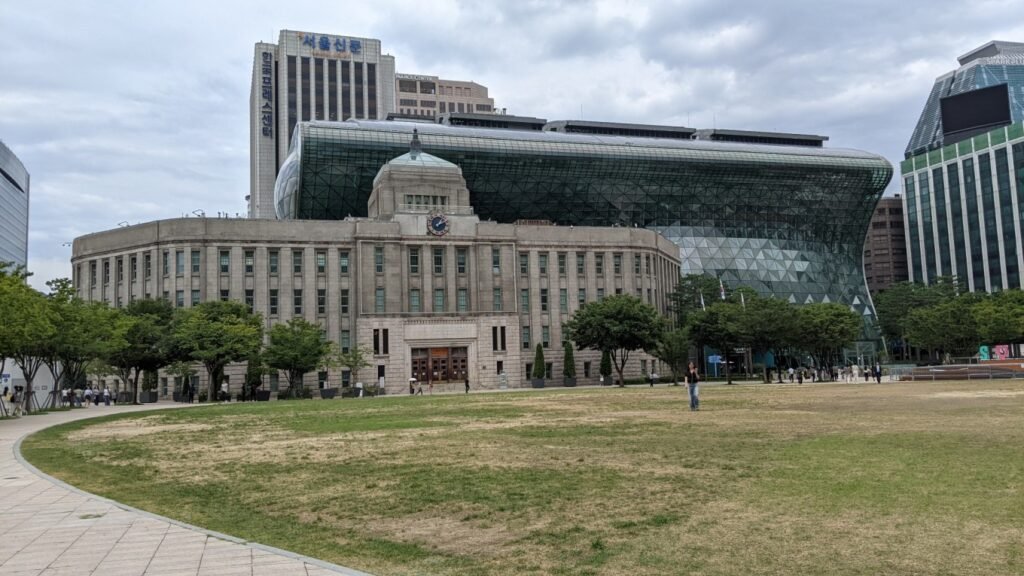

The curved glass exterior of the City Hall creates a striking visual contrast with its uniquely stylish and modern interior design, making a strong impression on visitors.


The Splendid yet Sparse National Palace Museum
The National Palace Museum is tucked away in the southwest corner of Gyeongbokgung Palace, with an entrance that’s easy to miss. The museum’s main hall is on the second floor, built on a high foundation. The reception desk has windows for Chinese, Japanese, and English speakers, as well as a bag-check area. However, the second-floor hall is closed for renovation, and the first-floor hall is hosting a virtual exhibition on Notre-Dame Cathedral in Paris. Only the basement level is open, displaying exhibits on the founding of the Joseon Dynasty and royal ceremonies.
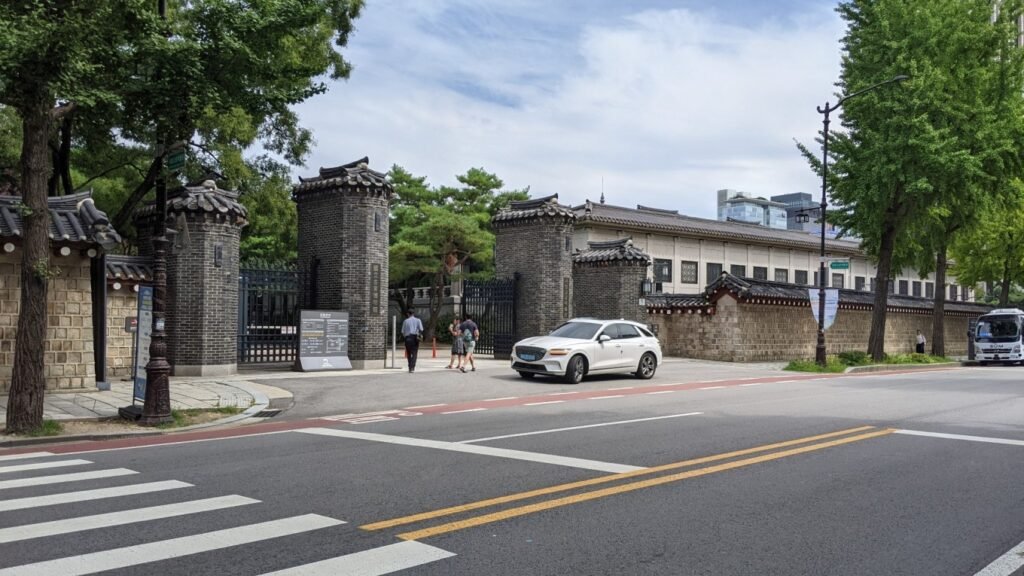
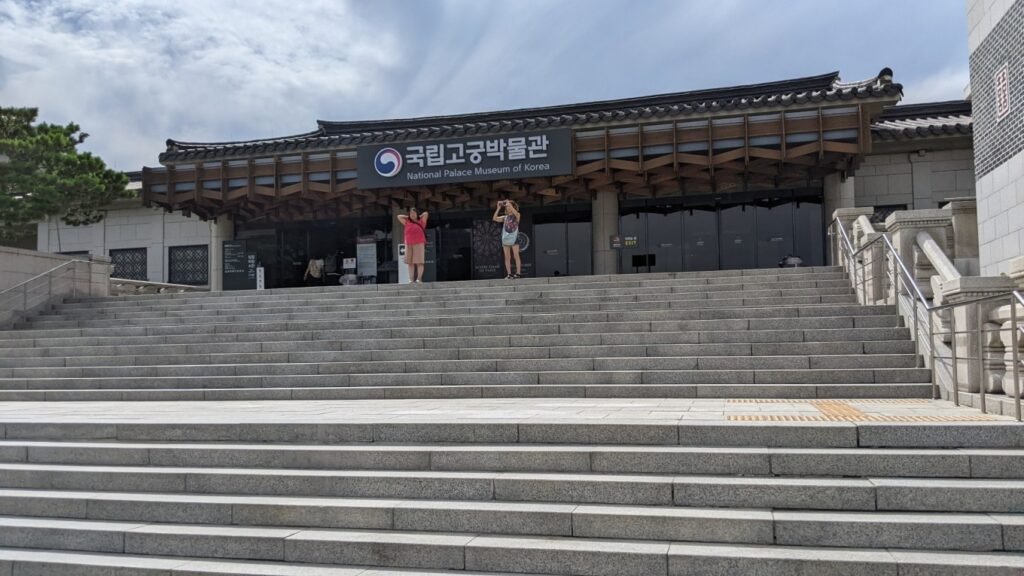

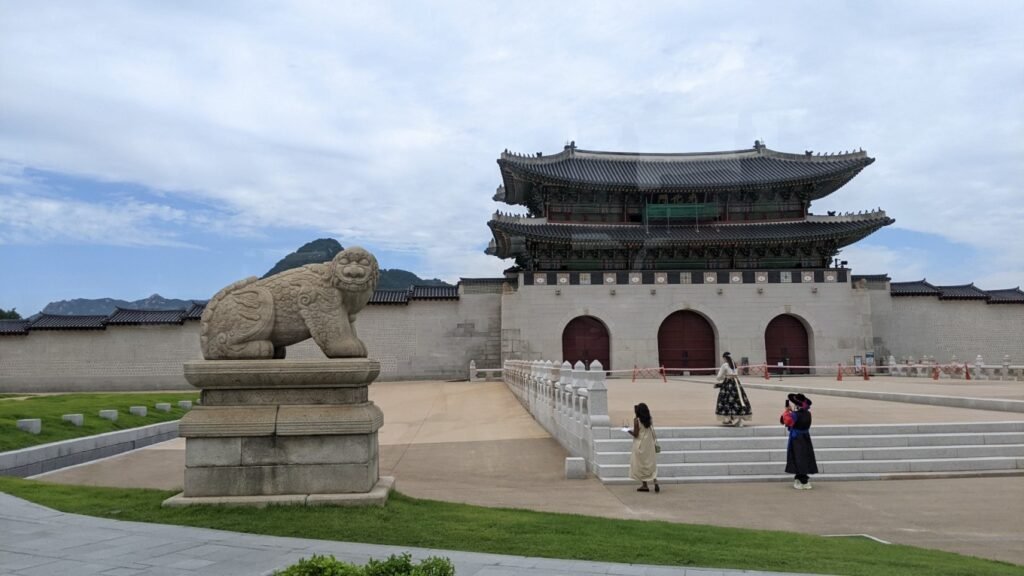
In the basement of the National Palace Museum, there are two vintage cars from over a century ago that once belonged to Emperor Gojong, the founder of the Korean Empire.

As I stepped out of the National Palace Museum, the dark clouds had completely vanished. In the blue sky, dotted with white clouds, I caught a distant view of Gwanghwamun and Heungnyemun gates of Gyeongbokgung Palace, illuminated by the setting sun.
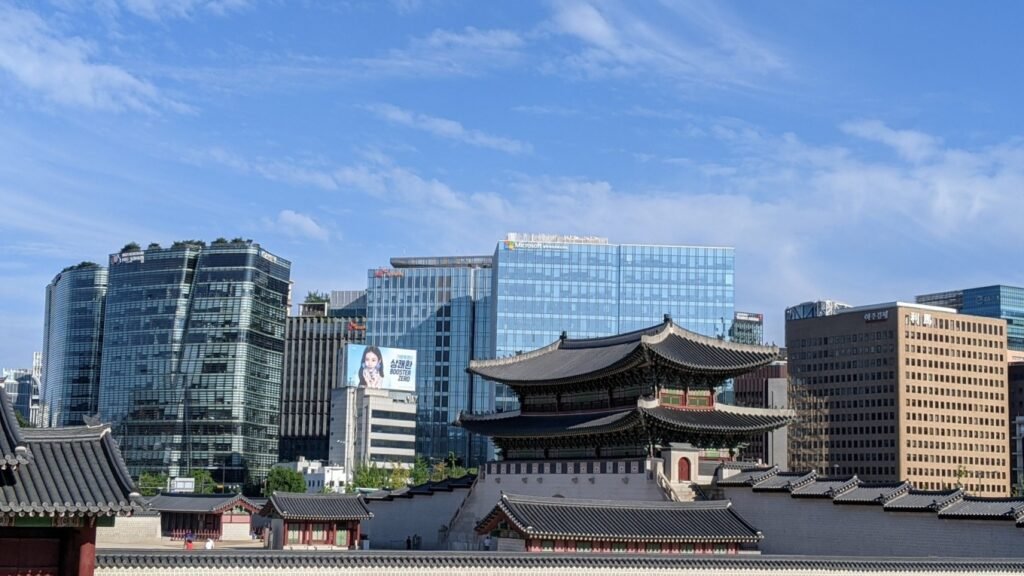

DAY3
On a clear morning, jet lag had us up early, wandering the streets in search of breakfast, but with no luck. So, we decided to do as the locals do—grab some instant noodles, head back to the room, and enjoy a steaming bowl. I then set off on my own to Gyeongbokgung Palace to watch the guard-changing ceremony and join the English tour.
As I emerged from the subway station, the National Palace Museum stood bathed in the morning sunlight.
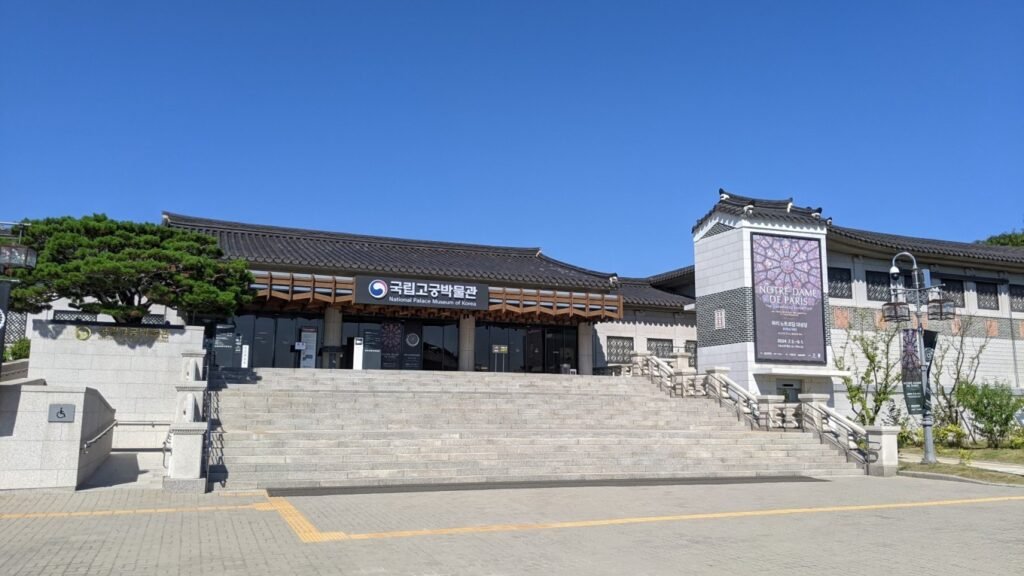

Gyeongbokgung Palace Guard-Changing Ceremony
In the plaza between Gwanghwamun and Heungnyemun gates stands a large drum used during the guard-changing ceremony. Following the sound of the drum, I arrived at a small training ground outside the east gate, where the guards were assembling and rehearsing. Once they were ready, they marched in formation towards the ceremony plaza. The captain of the guards led the honor guard to the ceremony site, where the changing of the guard was announced in Korean, English, Chinese, and Japanese, detailing each step of the process.
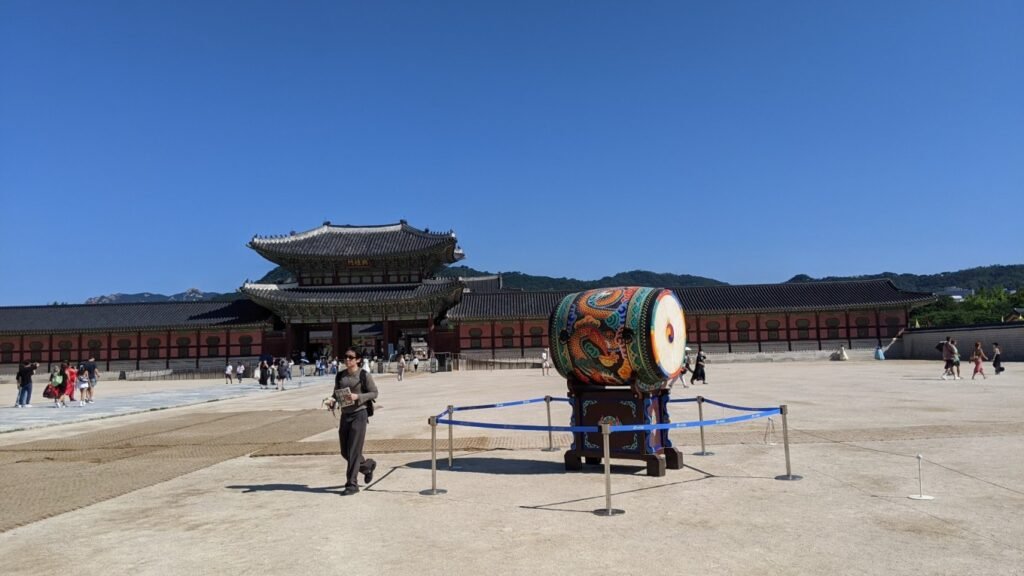



The defending generals exchanged names and passwords and began the handover. Drums were beaten as a signal and military music played in unison.

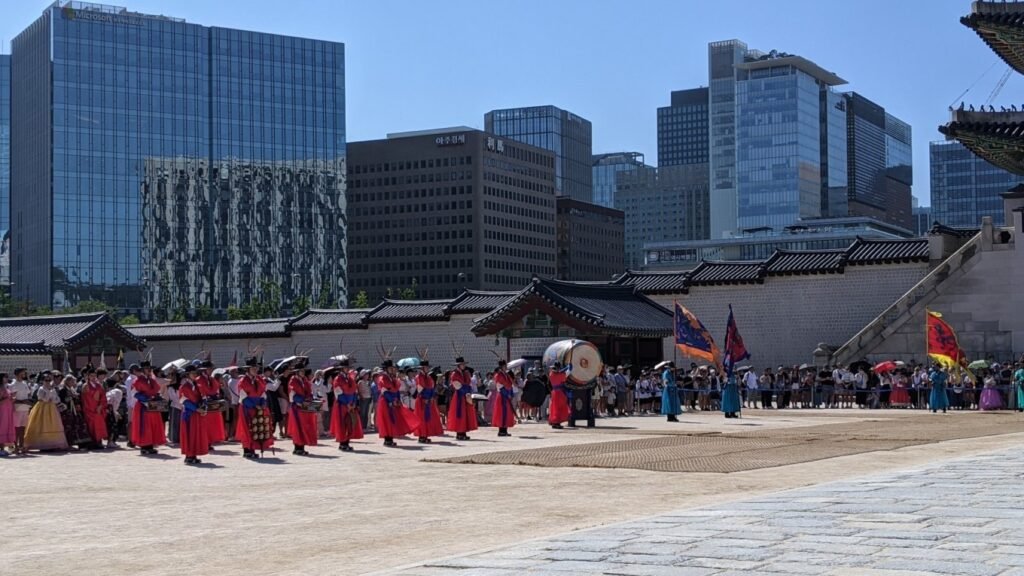
Upon entering Heungnyemun Gate, I waited near the guide map by the visitor information center for the tour, which was offered in Korean, English, Chinese, and Japanese. Due to the weather, the tour duration was shortened from the usual 50-60 minutes to 30 minutes.
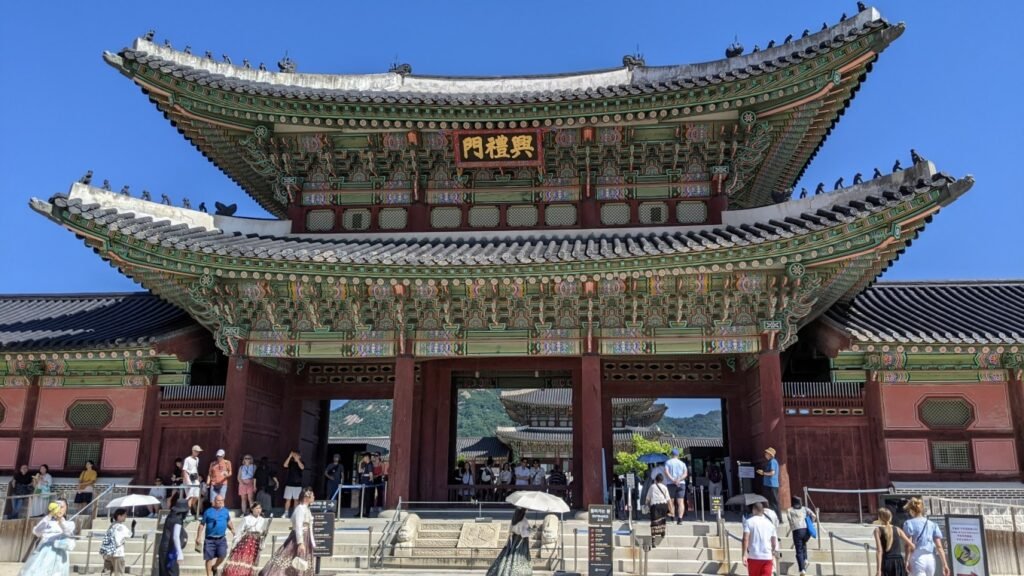
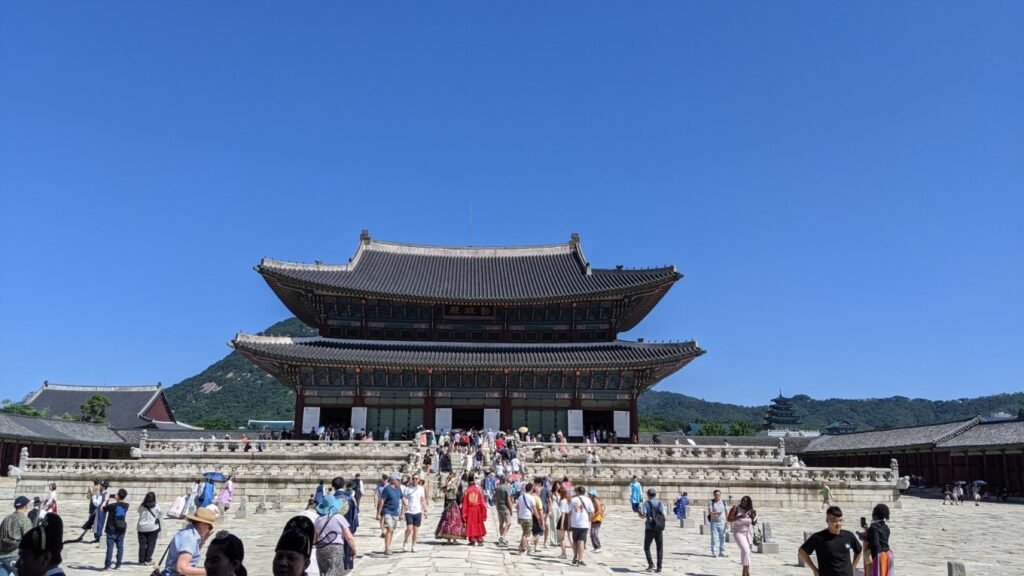
The dragon throne and the picture of the sun, moon, and five peaks in the hall.
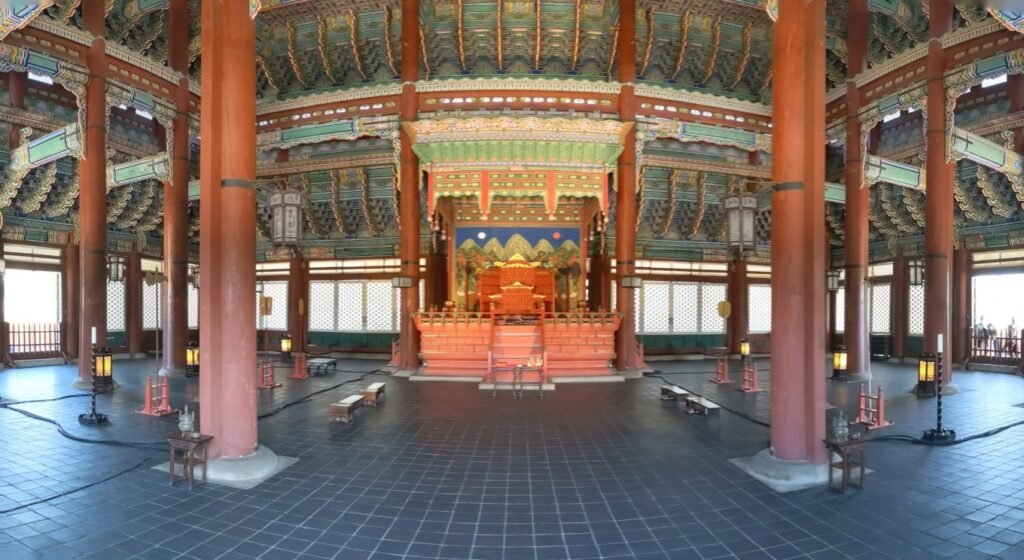
The gilded picture of the dragon and phoenix playing with a pearl on the ceiling in the center of the hall. According to the tour guide, there is also such a pattern on the ceiling above the dragon throne.

The most beautiful open pavilion inside Gyeongbokgung Palace is Gyeonghoeru, a waterside structure where the king hosted banquets for foreign guests. It was in the nearby hall, Sajeongjeon, in 1443, where King Sejong of the Joseon Dynasty issued the creation of Hangul, the Korean phonetic script.
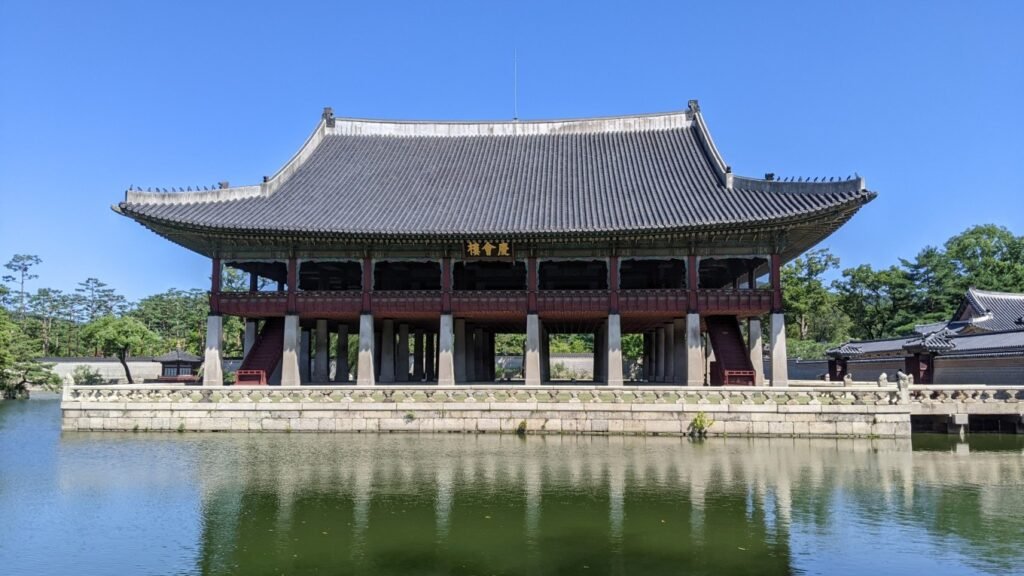
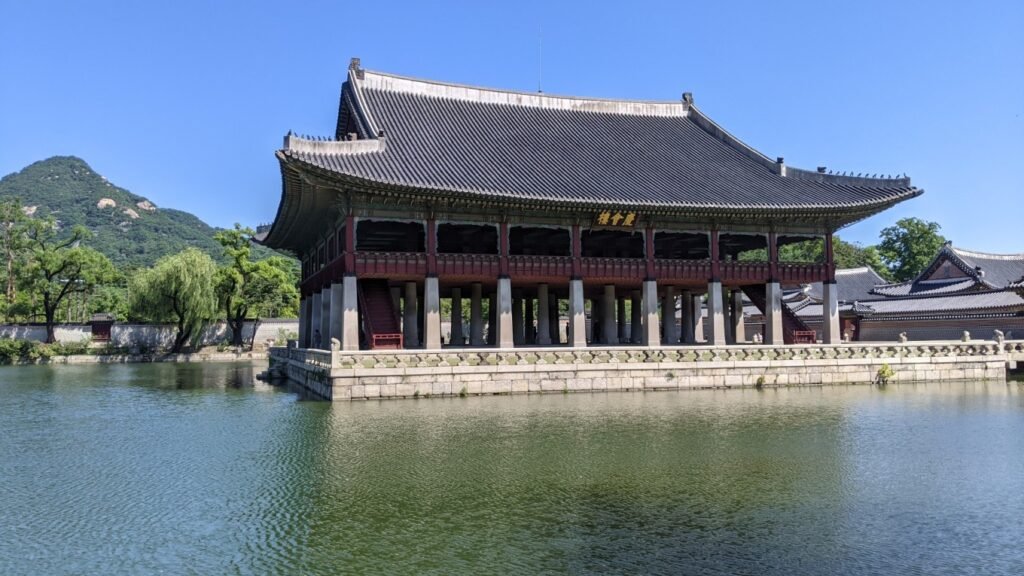
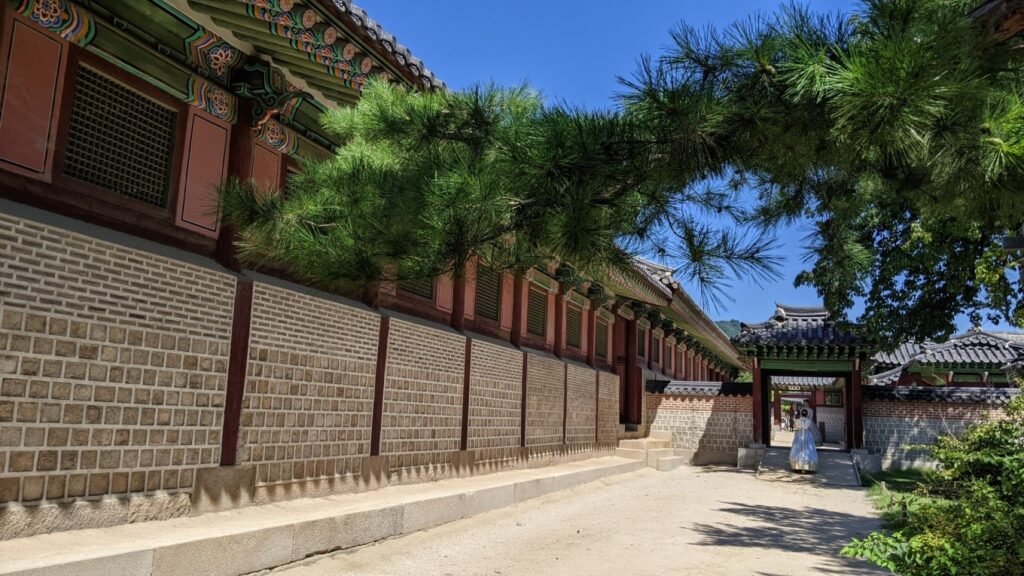

The Heungbokjeon Hall complex, originally built by Emperor Gojong in the 1860s, stands out with its unique architectural style, distinctly different from the other buildings within Gyeongbokgung Palace.

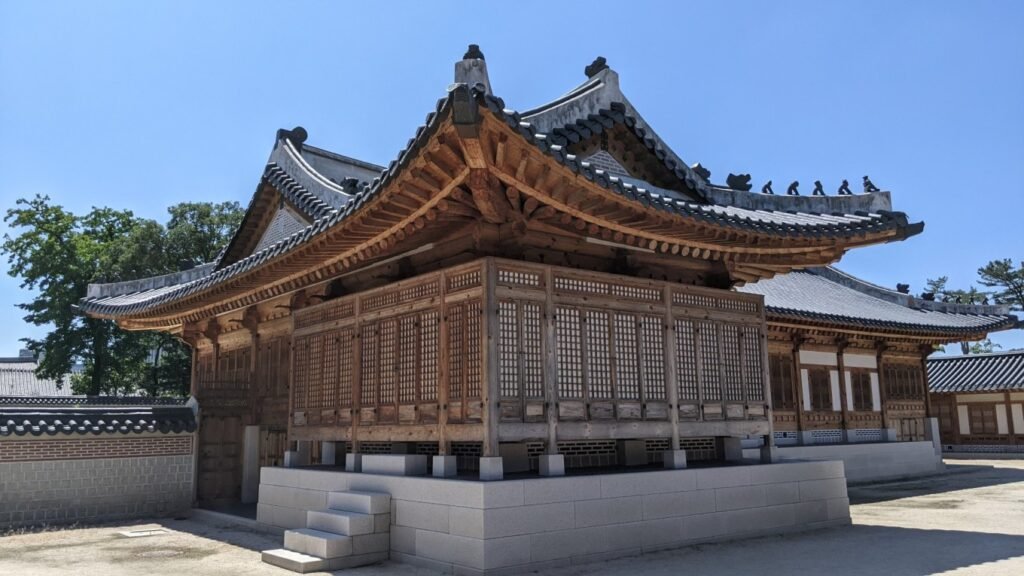
Approaching the mysterious Blue House (Cheong Wa Dae)
The tour guide reminded us that the northern gate of Gyeongbokgung Palace is closed. However, you can reach Cheong Wa Dae, located directly north of the palace, by exiting through the side gate west of Gyeonghoeru.




Cheong Wa Dae (The Blue House) served as the rear garden of Gyeongbokgung Palace during the Joseon Dynasty (1392-1910) and was also used for palace examinations, military training, and agricultural ceremonies. Most of its buildings were destroyed during the Japanese occupation (1910-1945). From 1948 to 2022, it was the official residence and office of the South Korean president. In 2022, in line with the elected president’s campaign promise, it was opened to the public for free.
Visitors can now make a free reservation online. At the entrance, you need to scan the reservation QR code, which is valid for the day of booking. There’s no need to enter at a specific time within your scheduled visit.

The Presidential Residence at Cheong Wa Dae
A panoramic view of the Cheong Wa Dae Presidential Residence.

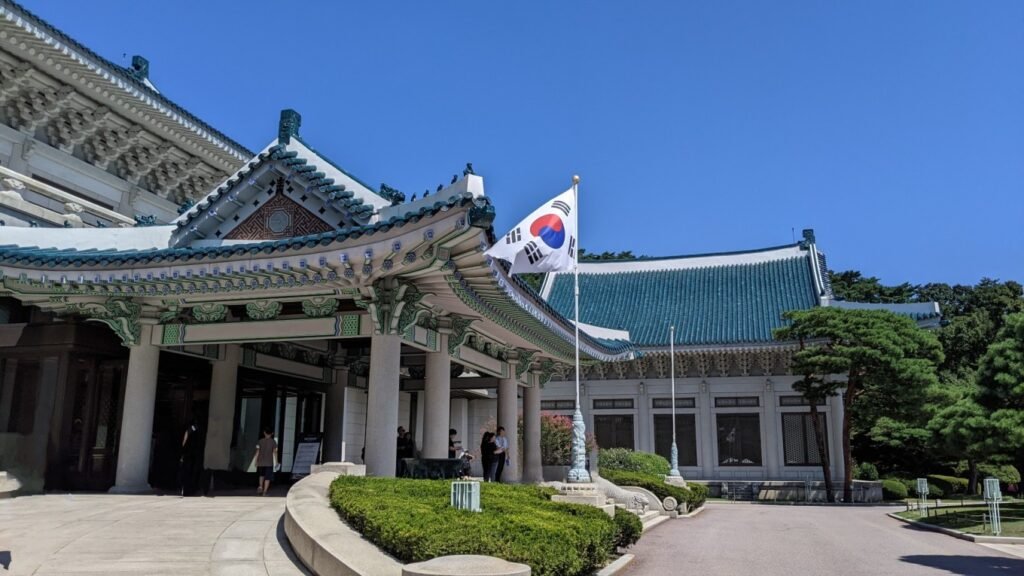
The grand staircase at the main entrance leads to the second floor.
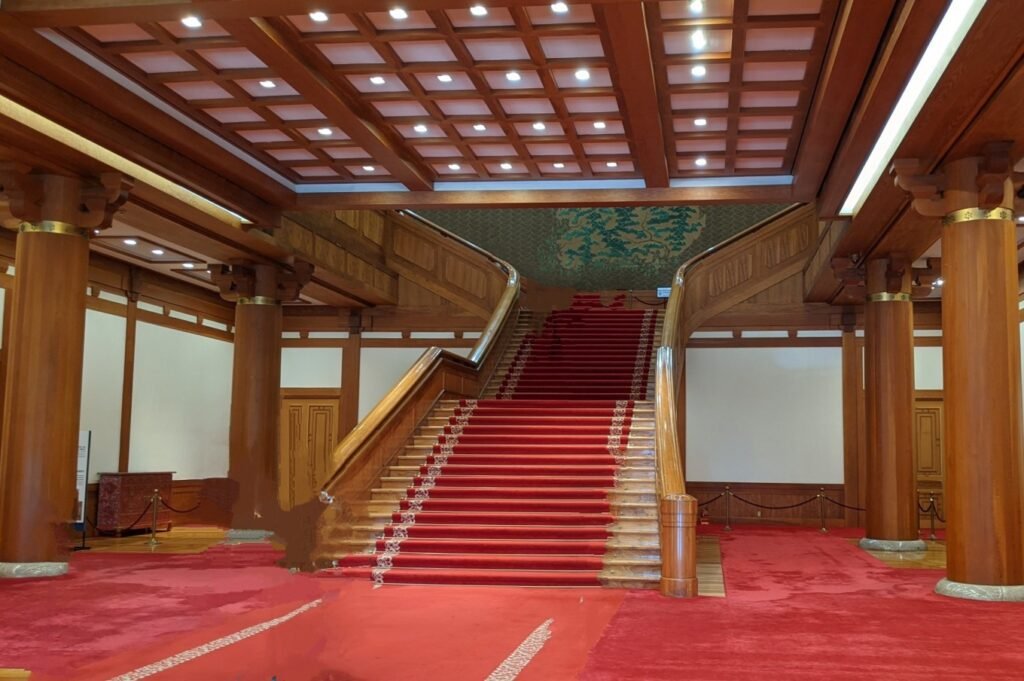
At the far end of the west wing is the cabinet meeting room.
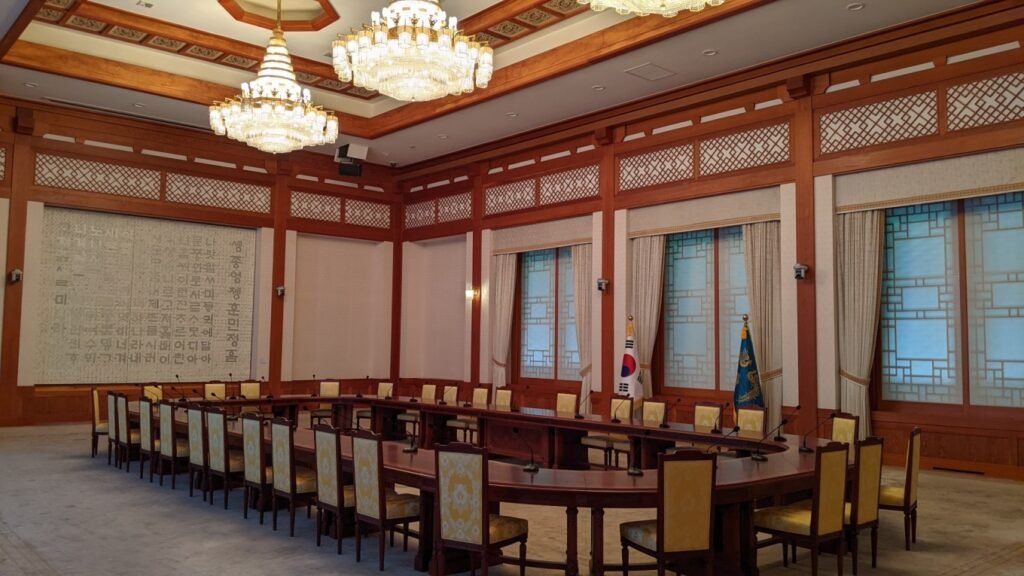
In the foyer outside the meeting room, portraits of the 12 former presidents who once resided at Cheong Wa Dae are displayed. It’s said that, except for the last president, Moon Jae-in, all of these individuals were either embroiled in scandals or met unfortunate ends. Fortunately, no more portraits will be added here in the future.

The white banquet hall, styled in a Western fashion.

The hall of the east wing.

The porch outside the hall is adorned with folding screens.
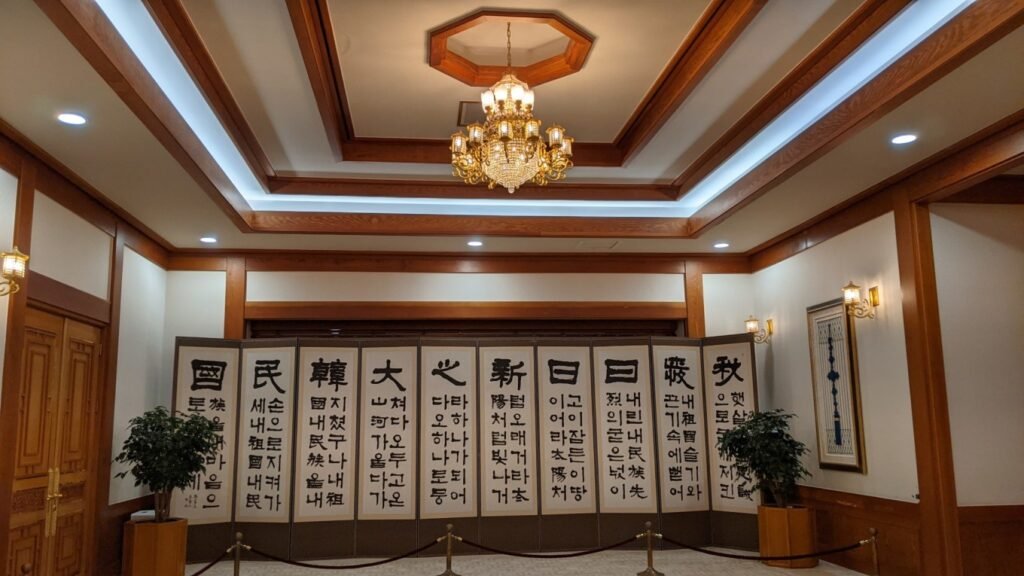
Behind the staircase on the first floor is the social venue for the first ladies of past administrations—although South Korea’s first female president, Park Geun-hye, remained unmarried throughout her life.

The president’s office.
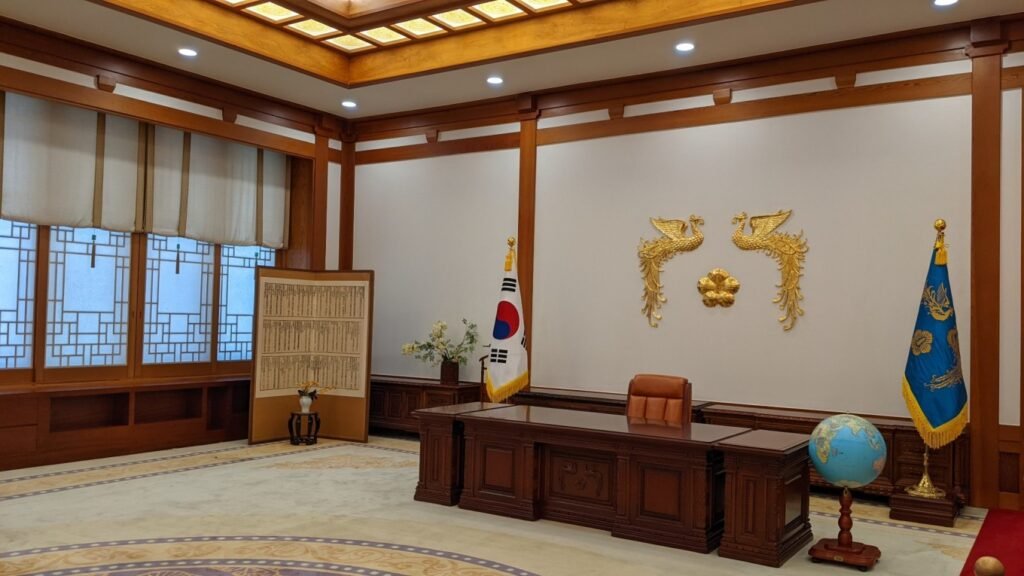
The reception room, featuring a mural titled “The Ten Longevity Symbols.”

On the wall hangs a map of the Korean Peninsula. A mother is seen asking her child about the location of the 38th parallel.

Behind Cheong Wa Dae: The Mountain, Lawn, and Presidential Residence
After leaving the Cheong Wa Dae Presidential Residence, there’s a staircase path to the left, just past the eastern fence gate, leading up the back mountain. Climbing up, you’ll reach the rear of the mountain, where you can enjoy a view of the Seoul Tower to the south and the Presidential Residence nestled below at the foot of the mountain.


Walking around the buildings on the grounds, you can catch glimpses through the windows of the kitchen, dining room, and other areas inside the Presidential Residence, but entry into the residence itself is not allowed.
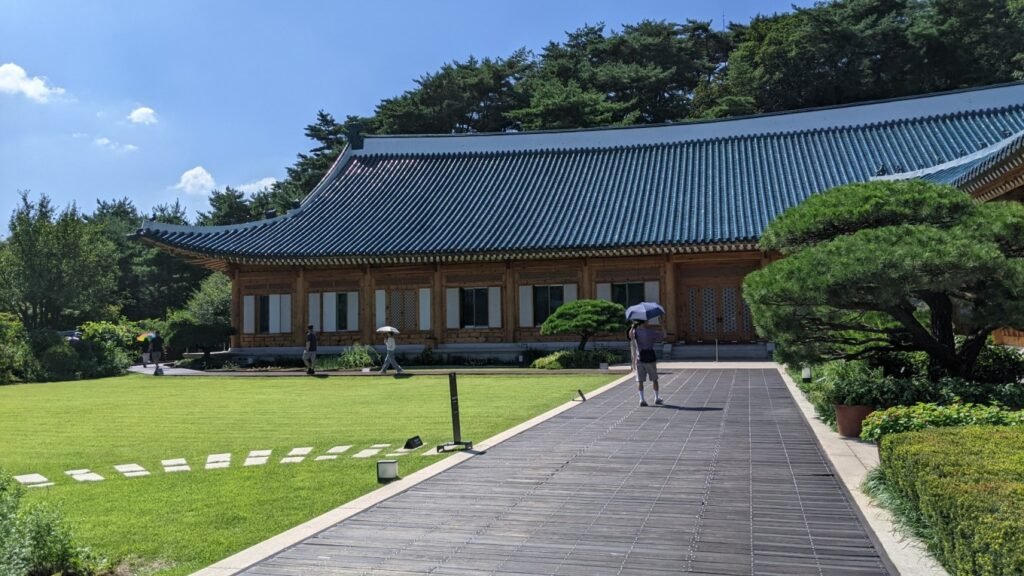

Near the East Gate exit is a welcoming rest area for visitors. From here, you can view panoramic scenes of both the Cheong Wa Dae Presidential Residence and the old residence.


The old residence was built in 1939 during the Japanese occupation and originally served as the official residence of the Japanese Governor-General. From 1945 to 1950, it housed the U.S. military headquarters in Korea. From 1950 to 1993, it became the official residence and office of the South Korean president. In 1993, after the completion of the new presidential residence, President Roh Tae-woo had the old residence demolished.
Cheong Wa Dae Observatory Hiking Trail
The trailhead is located just inside the security gate surrounding Cheong Wa Dae. The sight of the cylindrical guard post can feel intimidating, but fortunately, there are map signs along the way to provide reassurance and guide you up the trail.

Following the circular trail, you eventually reach the Cheong Wa Dae Observatory. From there, you get a sweeping, unobstructed view of Seoul’s cityscape.
Following the circular trail, you eventually reach the Cheong Wa Dae Observatory. From there, you get a sweeping, unobstructed view of Seoul’s cityscape.

DAY4
Experiencing Korea’s High-Speed Rail Express
Tickets can be easily purchased online in advance and printed out. You can board the train directly and take your assigned seat, with no interruptions during the journey—fast and convenient.
Seoul Station serves as a major transportation hub, integrating the Airport Express Line (B7), Subway Lines 1 and 4 (B3), and the train station (above-ground, three levels). The signs for lines and directions are clear, except when transferring from the express line to the subway. In the train station waiting area, departure platforms are displayed on large screens 30 minutes before departure. There are no ticket barriers, so passengers can go straight to the platform using the escalators corresponding to the platform number, find the correct train car, and then locate their assigned seat.
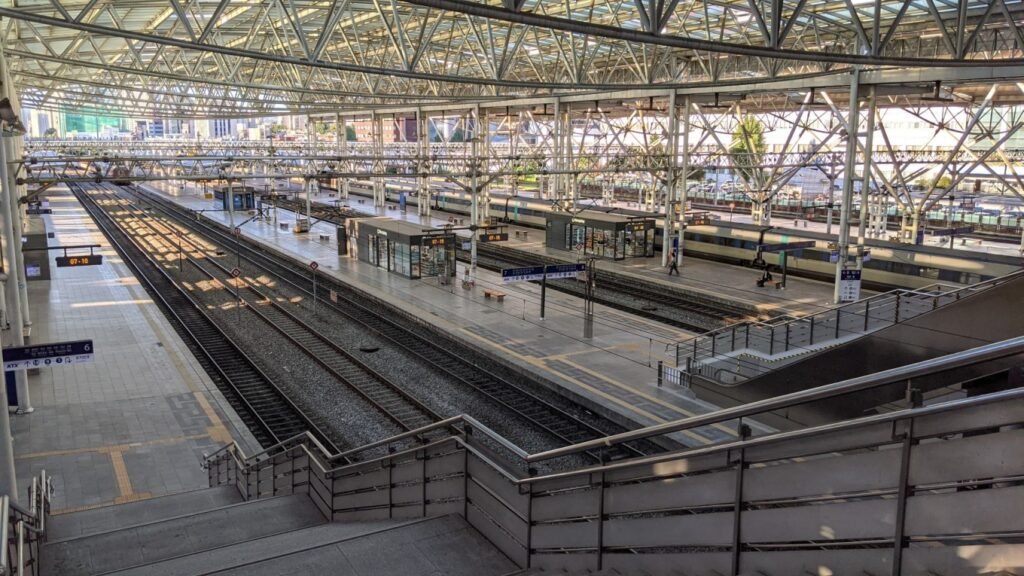

Busan Chinatown’s Chinese Association and Lunch
The Toyoko Inn is conveniently located right next to Exit 1 of the train station, but check-in isn’t until 4 p.m. After storing our luggage, we headed across the street to find lunch. First, we stopped by a small, family-run noodle shop that had just opened and enjoyed a bowl of naengmyeon (Korean cold noodles). Then we went to a Chinese restaurant called Yuan Xiang Zhai and ordered a seafood-flavored rice bowl, which unexpectedly became our must-have dish from then on.
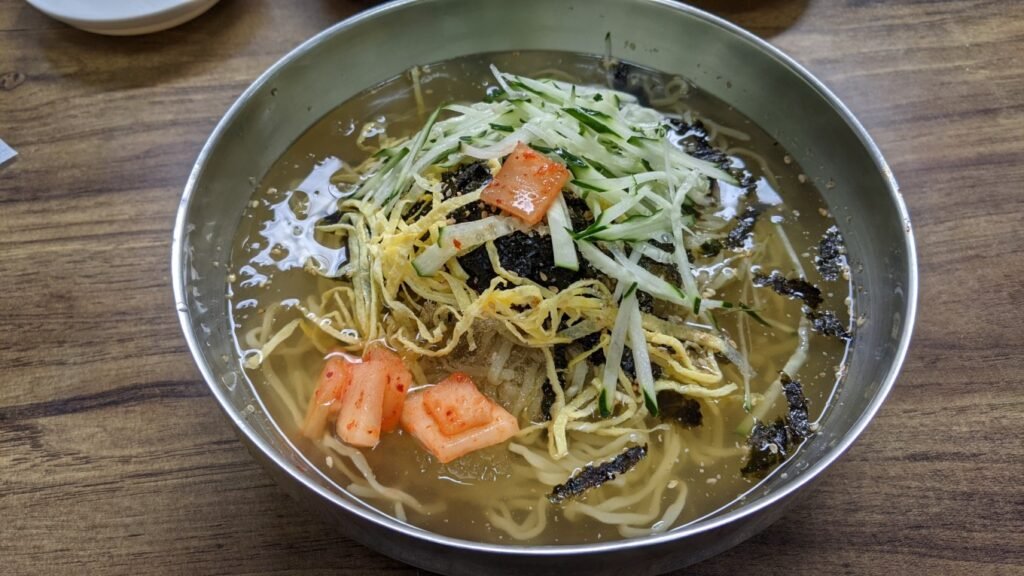
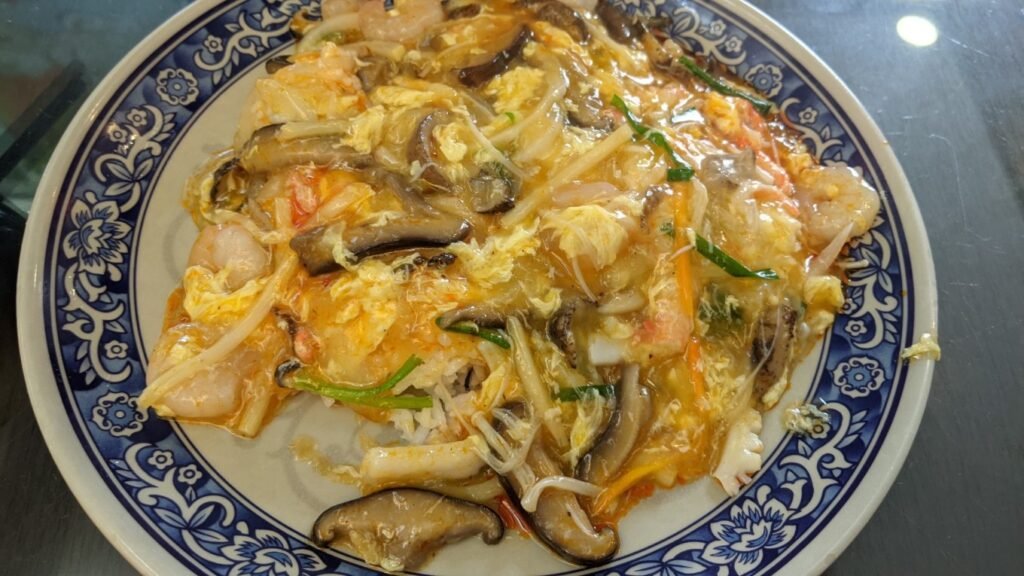
Taejongdae Coastal Hike

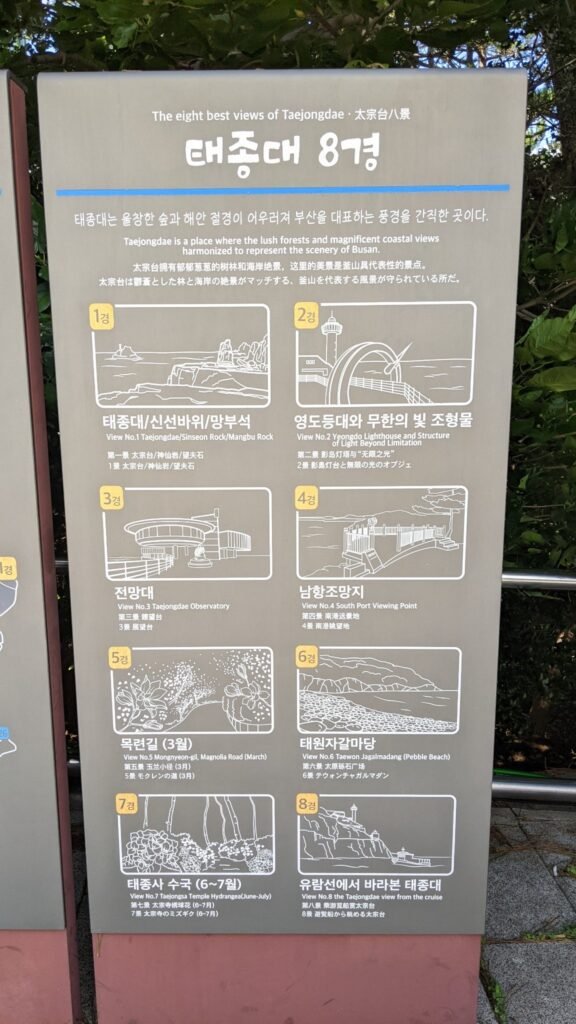


Next to the observatory stands a statue of a mother and child. It is said that the statue was placed there in hopes that young people contemplating suicide by jumping into the sea from this spot might be reminded of their mother’s love and choose to abandon such thoughts.
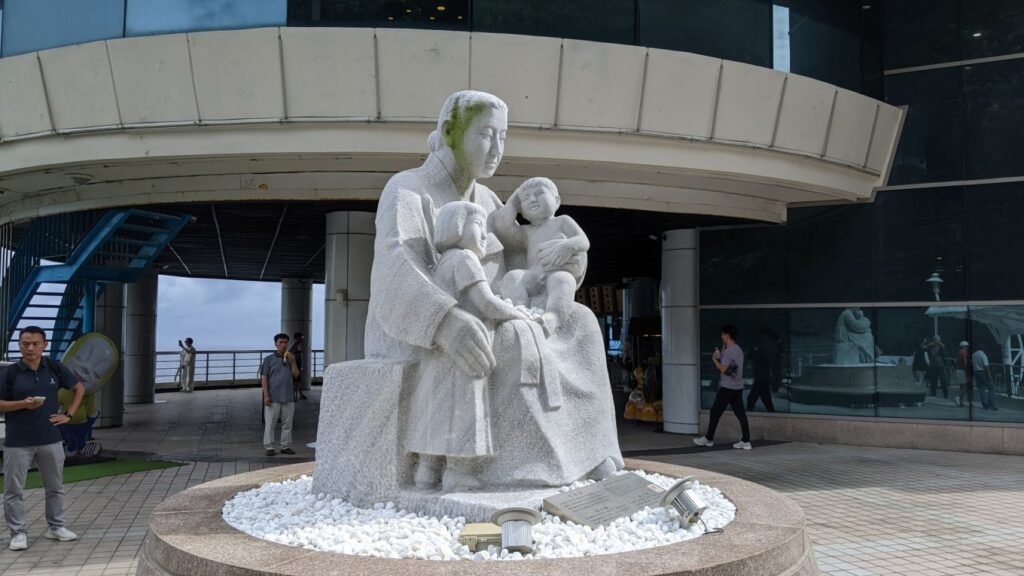
The wind and waves here are incredibly strong, making it nearly impossible to stand steady. The wind is so intense that it’s hard to catch your breath, and I had to grip my camera tightly with both hands to prevent it from being blown away.
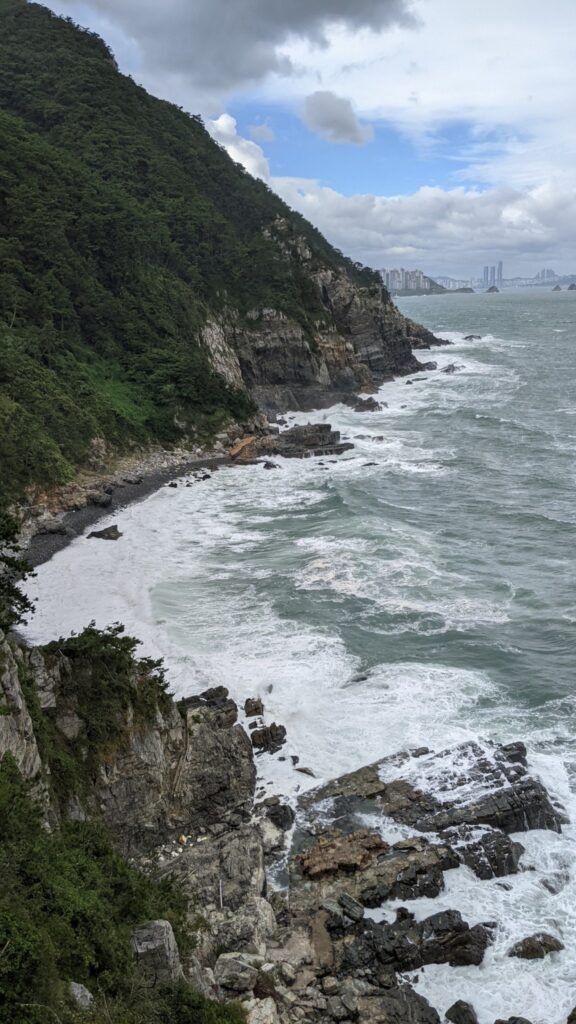

Although I was drenched in sweat during the first half of the hike, the strong, cooling winds at the observatory brought a drop in temperature. The second half of the hike even felt a bit chilly, and by the time I returned to the starting point, the heat had completely vanished. At some point along the way, I accidentally altered a setting on Google Maps, and even with an internet connection, it couldn’t plan my return route. Fortunately, I found the bus back just in time. While on the bus, I managed to fix the detour setting on the map, and I smoothly made my way back to Busan Station.

That sounds like a wonderful plan! The Oryukdo Coastal Trail offers some stunning views, and the sunset from the capsule train in Haeundae should be breathtaking. Enjoy your adventure! Let me know if you need any tips or information for the trip.
DAY5
Oryukdo Skywalk
The name “Oryukdo” comes from the appearance of the group of islets along the coast. From the east, you can see six peaks, while from the west, only five are visible, hence the name “Oryukdo” (meaning “five or six islands”). Interestingly, from the shore, only two of the peaks are visible, which adds to the intrigue of the place and its ever-changing landscape depending on your vantage point.


This spot marks the boundary between the South Sea (Namhae) and the East Sea (Donghae) of Korea. It’s a unique location where the two bodies of water meet, adding to the significance of Oryukdo’s scenic views and coastal beauty.


Oryukdo-Igidae Coastal Trail
A Detailed Explanation of the Origin of Oryukdo

The visitor center next to the Skywalk offers informational materials about the local attractions, and they even provide free small magnets as souvenirs.
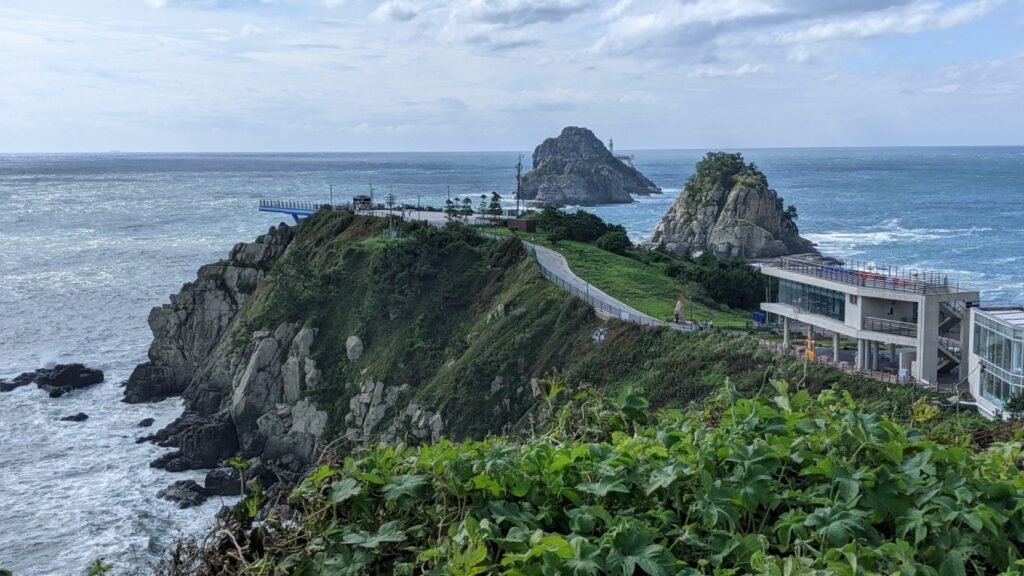
The trail gradually enters the mountains.


The Capsule Train at Sunset
The plaza in front of Busan Station.
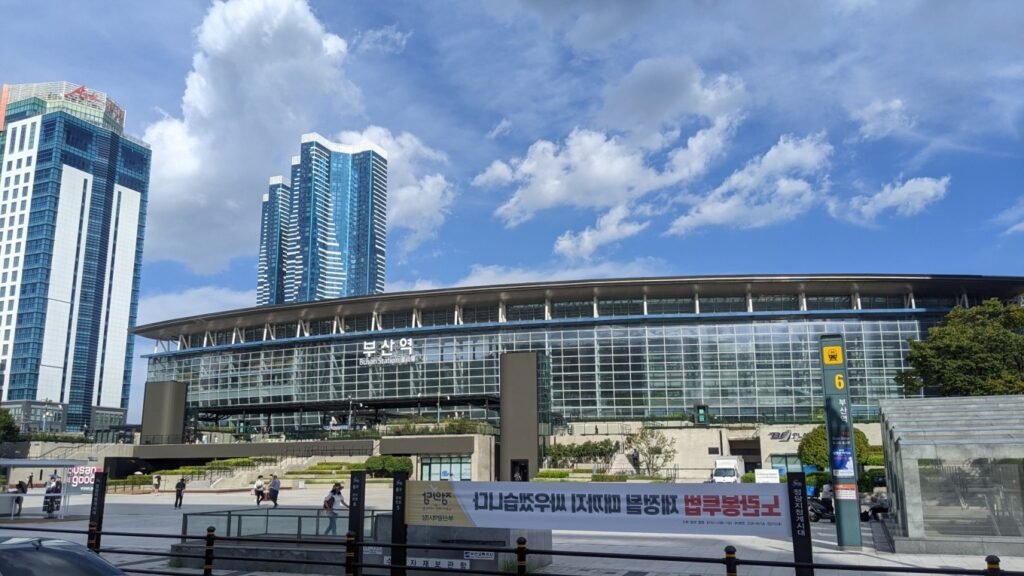
At sunset, the queue for the capsule train was already forming. The ride lasts about 30-35 minutes, and the sunset that day was scheduled for 6:53 p.m. However, the waiting time varied greatly, sometimes as short as 15 minutes, but sometimes stretching up to 45 minutes. After careful consideration, I reserved tickets for the 6:00-6:30 p.m. time slot. I arrived at the ticket check at 6:05 p.m. and communicated with a young man in a wide-brimmed hat using a translation app, hoping to catch the sunset.
He advised me to join the queue by 6:20 p.m. to avoid a long wait, explaining that the people sitting on the right side in the waiting area had tickets for the 6:30-7:00 p.m. time slot, and he would let them in after 6:20. At 6:15, he kindly reminded me again, but I stubbornly believed that if I queued up then, I could board right away. I was hoping to witness not just the sunset but also the magnificent afterglow, thinking that boarding at 6:20 or even 6:30 would be the perfect timing.
In reality, the seats on the left and in front slowly filled up with waiting passengers. At 6:20 p.m., with a single call from the young man, everyone began filing into the queue, entering the waiting corridor in an orderly line. This marked the start of a long wait, as the capsule trains arrived leisurely, unloading passengers and then pausing briefly before taking on the next group. The interval between trains was around 1-2 minutes, adding to the sense of slow anticipation.
Finally, at 6:45 p.m., we were able to board the long-awaited red capsule train.
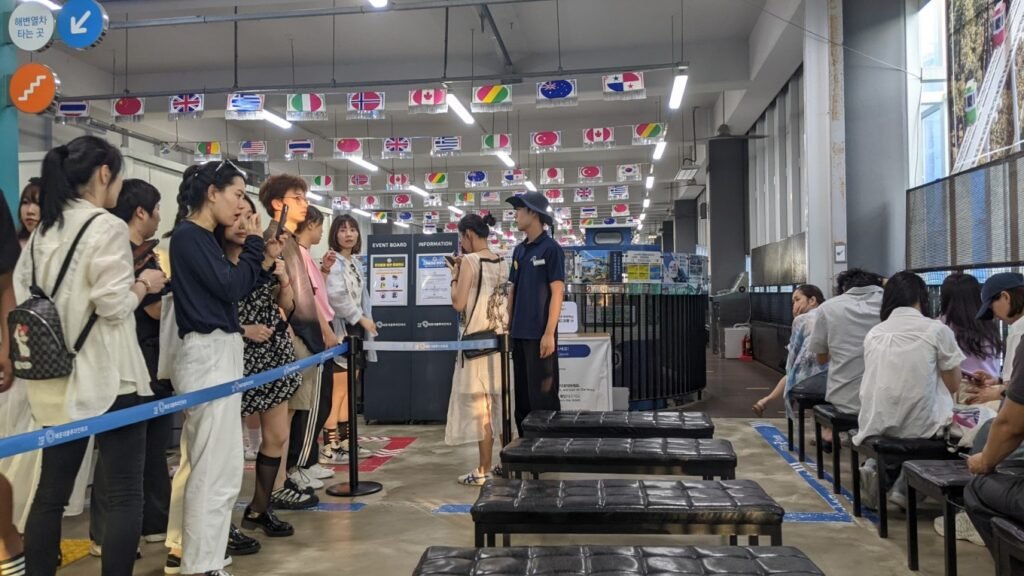

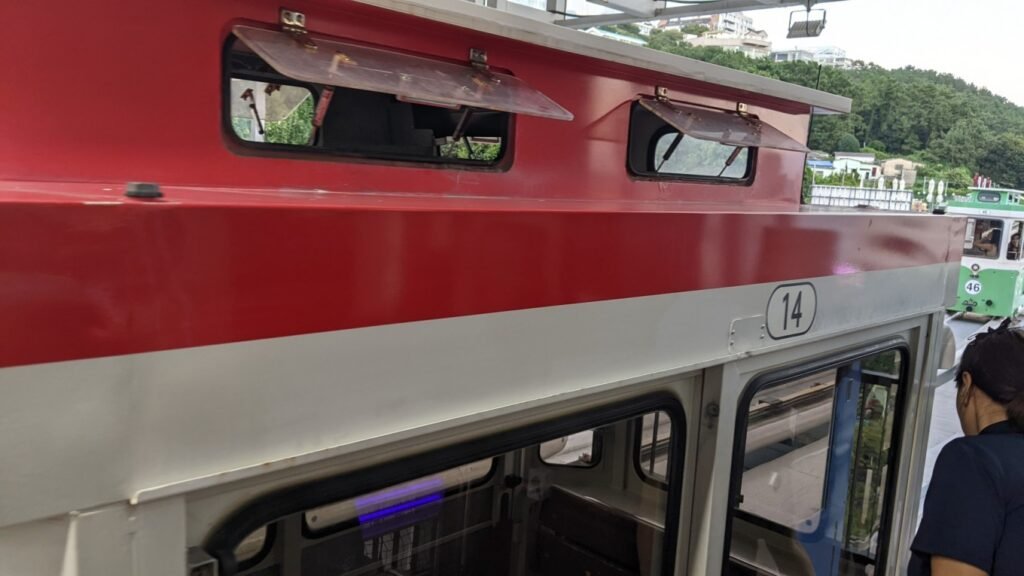
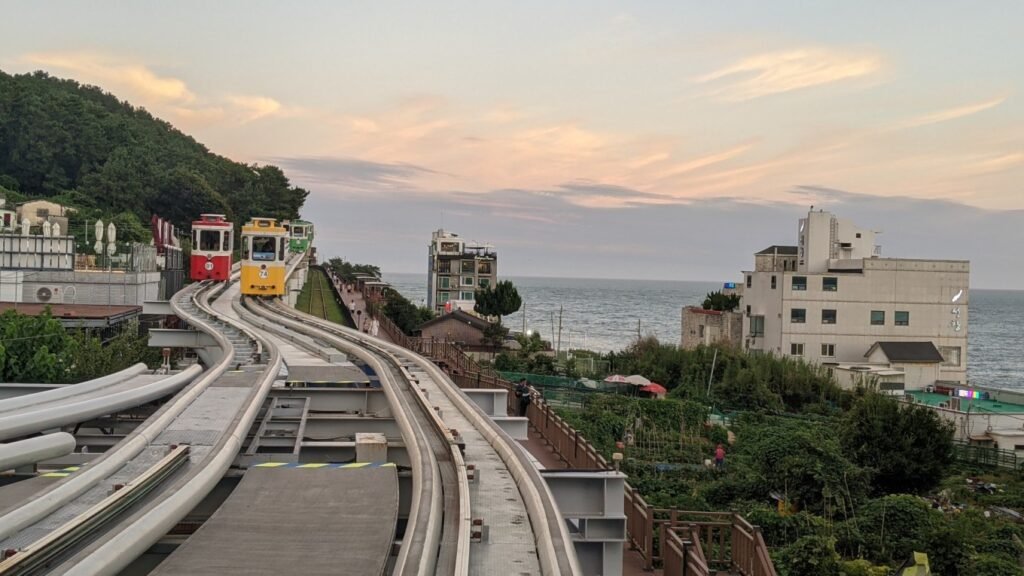
Unfortunately, by the time we boarded, the sunset had already been blocked by the distant mountains, and the clouds didn’t cooperate either. What a pity! If we had boarded 10-20 minutes earlier, the view might have been much better.
Hiking Along the Coastal Boardwalk Back to Mipo Station
There are three options for returning to Mipo from Cheongsapo: the capsule train, the regular train, or a coastal hike along the boardwalk.
You’ll also notice the unique and colorful food advertisements along the way, showcasing Korea’s distinctive cuisine.
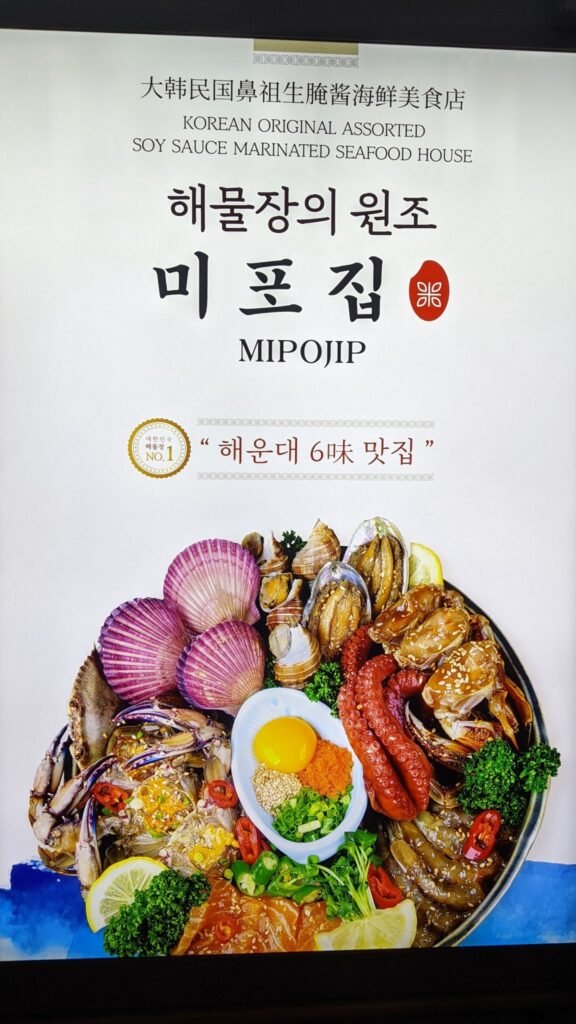
DAY6&7
Today (Day 6), I’ll be taking an afternoon train from Busan back to Seoul, but I still have time in the morning to visit nearby Songdo Bay for a cable car ride and a hike.
The Songdo Bay Skywalk
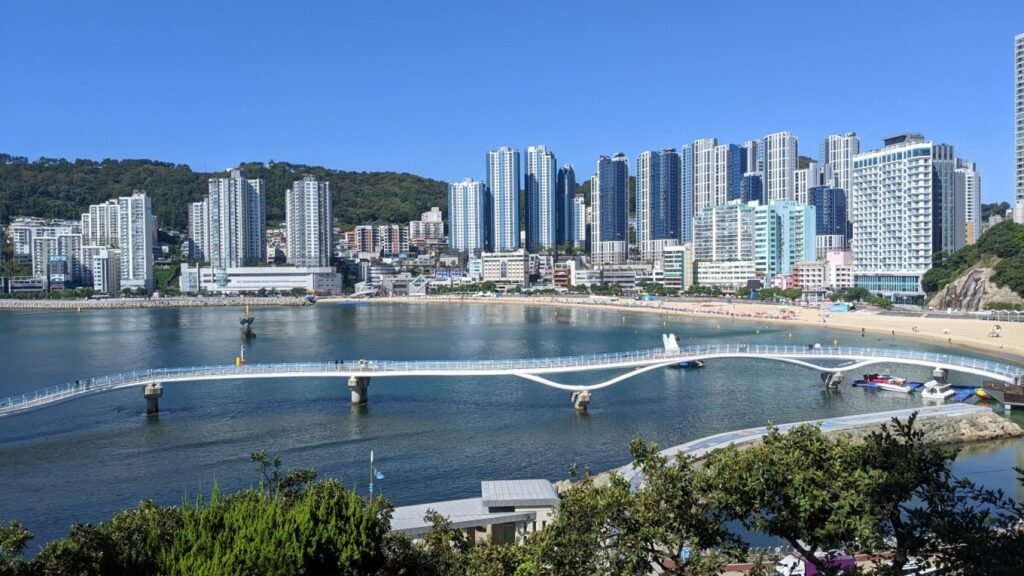



A Bird’s-Eye View of Songdo Bay from the Cable Car
There are two types of cable cars: regular and those with a transparent floor (though the calm water below doesn’t provide much visual impact due to the lack of reference points, the main advantage of the transparent floor is that there’s no need to wait in line—just board right away). Tickets are available for one-way or round-trip. If you opt for a one-way ticket, you can hike back along the trail, passing cliffs and beaches, but be prepared for the lack of shade along the way. Under the blazing sun, it can feel like you’re being roasted.
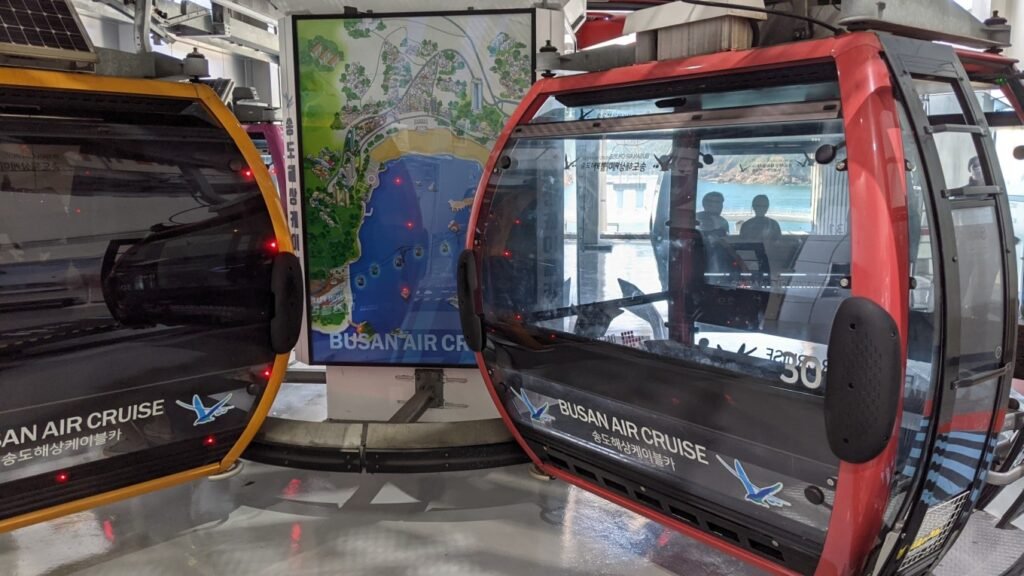

The Circular Suspension Bridge Connecting the Islets – The entrance fee is 1,000 KRW (make sure to bring some cash!).
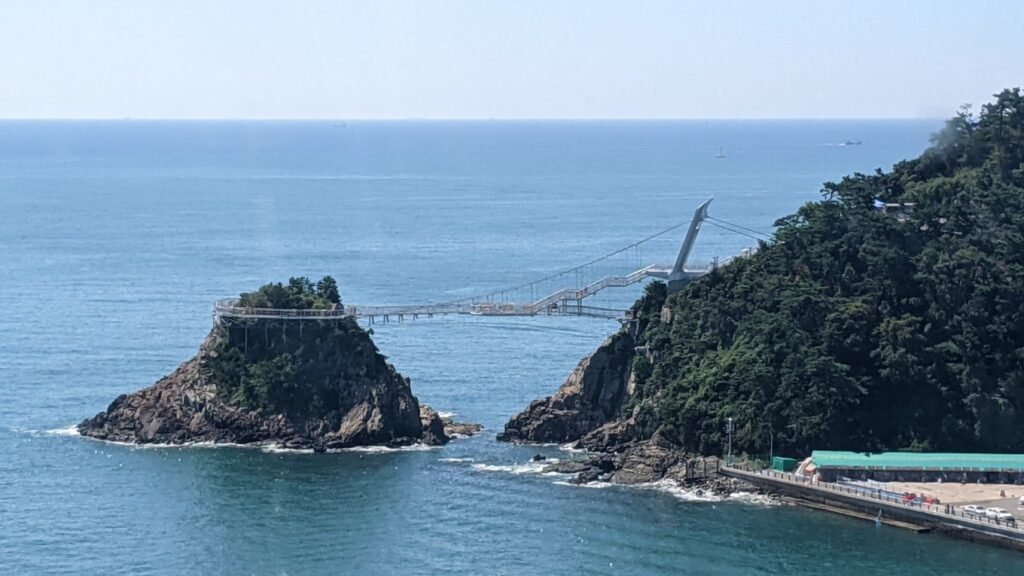

High-Speed Train Back to Busan
After leaving the cable car station, I hurriedly walked under the bridge and found the return bus. The bus stop even had multiple wireless charging stations available.
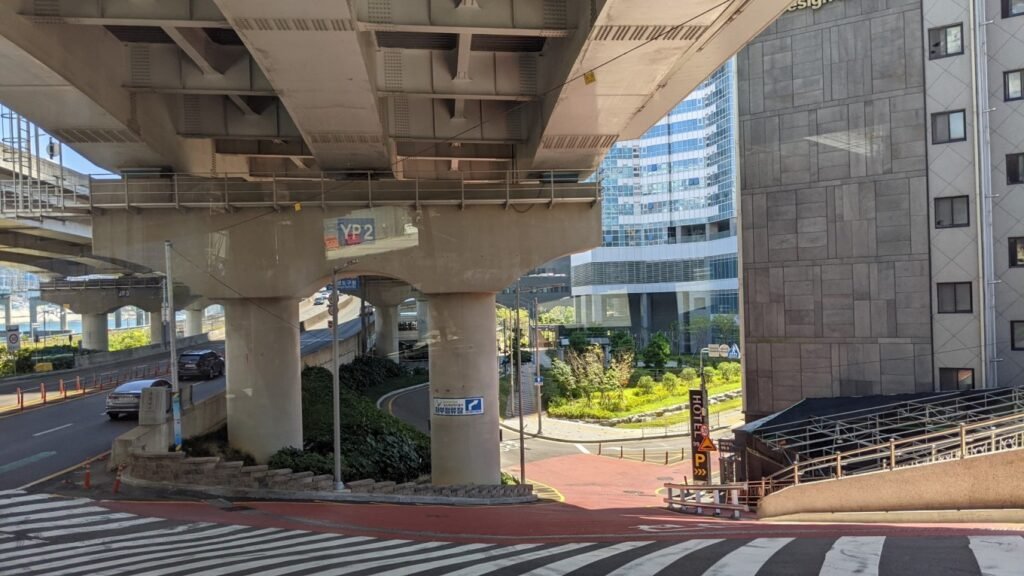
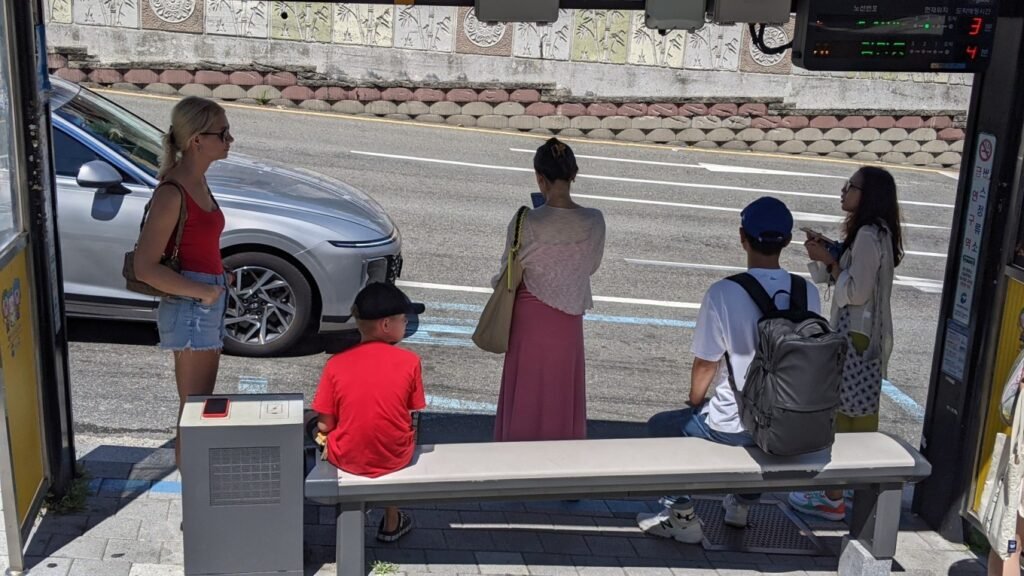
After arriving at Seoul Station, I first went to the hotel near Chungmuro Station to retrieve the luggage I had stored there, and then headed to Myeongdong Station. I was pleasantly surprised to find that entering and exiting the station didn’t incur any extra charges. However, many exits at Seoul’s subway stations require carrying luggage up and down stairs, which is quite inconvenient.
The bustling Myeongdong night market offers a wide variety of street food: buckwheat noodles (naengmyeon), gimbap (seaweed rice rolls), egg cake, spicy rice cakes (tteokbokki), and more.
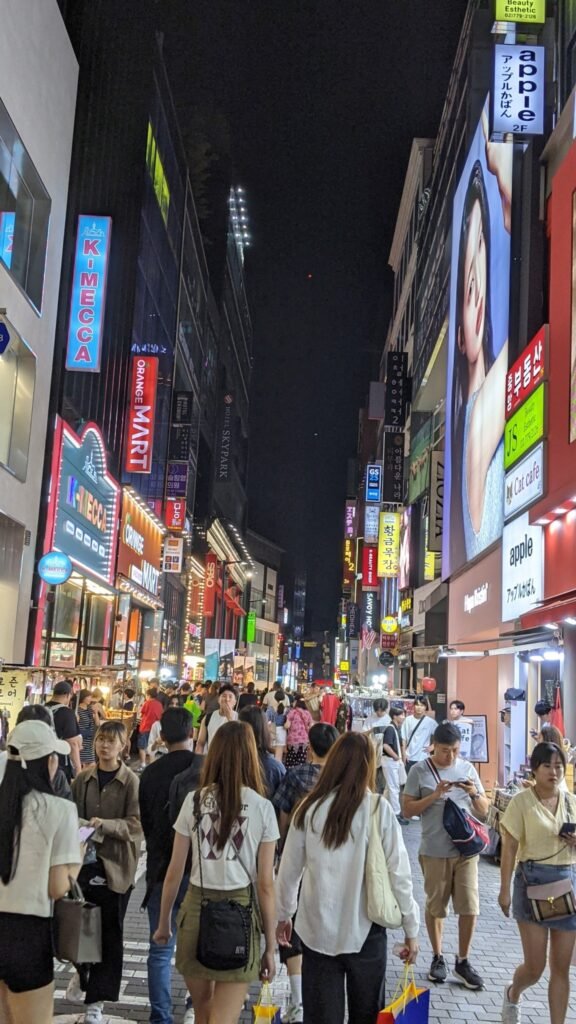



The Next Day
Learning from past experience, I used my T-Money card directly to enter the subway when heading back to the airport. At Seoul Station, I transferred to the regular Airport Express train (which is 15-20 minutes slower than the direct train, but isn’t crowded despite not having assigned seats). When exiting at the airport, the service desk manually calculated the transfer fare (4,500 KRW, which seems to be less than riding the regular Airport Express train alone). This method allows you to avoid leaving unused cash on the T-Money card, making it a very convenient option.

